Outline History of the British Railway Network
This section provides an overview of the railway system in Britain, general background information on the situation outside the railways fence is contained in Appendix One. A more detailed discussion of the railways locomotives will be found in Appendix Four - Locomotives and DMUs
By the mid 17th Century wagons running on wooden rails were
widely used in British industrial locations (mainly mines), allowing heavy loads to be easily moved
over rough ground.
The early railways of the eighteenth century were all horse-drawn
and were mainly quite short having been built as feeder services for canals and
riverside berths. Up to this point all the railways built had been constructed
by mine owners or other industrial users to move their own goods and although
many of these also carried other peoples goods on a contract basis they were
not obliged to do so by law.
These early lines were often built on
privately owned land (often the 'Estate' of the landowner operating a mine or
quarry) and hence required no special permission to be built and operated. Once
the line extended beyond a private estate however things became more
complicated and the existing legislation for building canals was pressed into
service for railways. This meant that each line had to gain the approval of the
government and obtain an Act of Parliament authorising its construction and
operation. The passing of an Act makes the railway company a 'statutory'
company (which does not have the word Limited after its name) and allows the
compulsory purchase of land.
Most early lines were built with a specific
traffic in mind, stone and lime from quarries and lines feeding iron works were
both common. The first railway built under such an Act of Parliament was the
Middleton Railway of 1758, running between a colliery at Middleton and the town
of Leeds. This line was subsequently one of the first to use steam locomotives
and one section is now a preserved line and still operating with steam
locomotives. The West Somerset Mineral Railway was built to carry iron ore and
the Furzebrook Railway in Dorset was used to move 'ball clay' to the coast for
shipping to the Potteries, in general however coal traffic soon dominated the
scene.
The first truly public railway, on which the right of anyone to
send goods was enshrined in the Act of Parliament authorising the line, was the
Surrey Iron Railway of 1803, engineered by one of the great railway pioneers
William Jessop (see App One - Outside the Fence - Significant engineers and Inventors). This was the first true 'railway company' in the
world, and the first railway south of the Thames in Britain, it ran from
Merstham via Croydon to Wandsworth in Surrey and all traffic was hauled by
horses. In the event this line suffered from competition from new canals built
nearby and it ceased operating in 1848.
These horse drawn lines gave
useful service but there was a limit to the load a horse-drawn system could
carry. A typical 'train' moved between two and twenty tons at a speed of about
four miles per hour. In the period of economic recession following the
Napoleonic Wars and the defeat of Napoleon at Waterloo the cost of fodder for
horses had risen prompting greater interest in alternatives to horse power.
High pressure stationary steam engines had been pioneered by William
Murdock in the late eighteenth century and developed by Richard Trevethick in
the first years of the nineteenth century. These could be mounted beside the
track and were used to pull wagons up inclines and even along level ground
using ropes. Some of these hope hauled lines stretched over considerable
distances. The Cromford & High Peak Railway (the first true trans-pennine
railway line, fully opened in 1831) used stationary engines to operate the many
steep inclines with horses pulling wagons along the flat bits. This line was
leased by the London & North Western Railway from 1861 and taken over by
that company in 1887. The LNWR improved the line and introduced steam
locomotives for haulage on the level sections. The LNWR closed several inclined
sections of the line but the remaining incline at Middleton with its steam beam
engine remained rope-hauled until 1963. Once the incline was closed the
remaining level sections remained operational until 1967. If the line was short
with no curves a capstan could be mounted at the top of the incline and a
simple rope loop arranged so that the weight of the loaded wagons going down
could be used to pull the empty wagons up. If the loaded wagons were going up
hill (not common as most such lines were built from a mine to take goods to a
canal or river berth) tank wagons could be filled with water to act as the
counterweight. The loaded tanks would be added to the rake of empties (usually
no more than four wagons at a time) with empty tanks added to the rake of
loaded wagons. This did require a steady supply of water however and the
practice was not common. A more likely reason for seeing water tanks on an
incline would be to supply water to the boiler for the hoisting engine.
Some inclines would be too steep, railway stock is designed to be hauled along the flat not lifted using its couplings. The solution was to build a steep incline carrying transporter wagons built to run on the steep slope. Ordinary wagons can then be loaded onto the incline trucks, however this approach was rare and is associated with industrial lines. The example shown below is at a slate quarry in Wales on which the trolley loaded with loaded slate wagons lifts the trolley loaded with the empties.
Fig___ Steep incline in a slate quarry
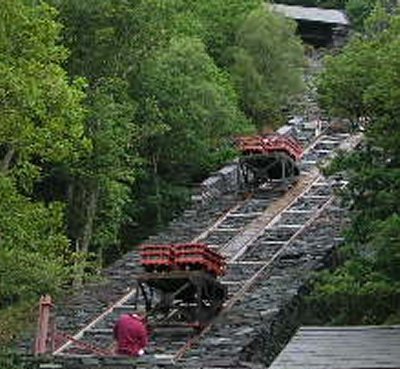
Photo taken in 2006 at a preserved slate quarry in North Wales, courtesy and copyright Brian Davies.
There
have been a number of examples of working rope-hauled inclines built in OO and
even some in N. Modelling a steam powered or gravity operated
rope-hauled incline in British N is complicated by the lack of a suitable
'rope', even in 4mm/foot it is difficult to find a suitably flexible thread
although nylon fishing line can be used. One option is to have the incline
disappear into a cutting, allowing straight lengths of wire to be used for the
'ropes'. A simple L shaped hook on the wire would engage the standard N
coupling hook, given a small 'pit' at the bottom of the slope this would
automatically disengage as the rake of wagons reached the bottom of the
incline. For gravity operated lines the two wires (up and down) need not be
linked as the wagons could be assumed to pass each other some way up the hill
and out of sight. This arrangement would allow wagons to be delivered and
collected via a siding linking the main line and the incline with no need to
model the associated industry.
An alternative to horse or cable
haulage on inclined track, where the flow of loaded wagons was downhill, was to
allow the loaded wagons ran down the line by gravity, their speed controlled by
a man riding on one of the wagons and operating a brake. On longer lines horses
were carried downhill in special wagons called 'dandy carts' to pull the train
back up the hill after unloading. The Welsh slate lines were rather fond of
this system of gravity working and it was 1863 before the first steam
locomotives appeared on the Ffestiniog Railway. A few gravity operated lines,
complete with the 'dandy cart' for the horse remained in operation into the
1930's. Unfortunately you cannot 'scale' gravity and making a working
horse is somewhat difficult, I do not know of any layout where empty wagons are
allowed to roll down hill in this way.
A related issue for modellers is
the gradient when changing from one level to another, such as raising one track
to pass over another. A gradient of 1:30 is about the maximum one should allow,
otherwise the engines will experience great difficulty in hauling anything up
the hill. One way of reducing the gradient involved is to lower one track as
the other rises, halving the gradient required. Even so an actual gradient of
1:30 remains very steep even for a model railway, 1:50 is preferable if you
have the room.
On the main lines in Britain where the gradient was steeper than
about 1:50 it was common practice to station an engine near the foot of the
hill to help by pushing from behind. As these engines were not coupled to the
train they could slow down and return to their post once the train had safely
reached the top of the hill. The engines used for this work were called
'Banking Engines'. The Lickey incline on the former Midland Railway line in
Worcestershire is I believe the steepest main line gradient in the UK, at about
1:38. The MR used tank engines for a time but then built a single heavy 0-10-0 loco
for the work (they built a spare boiler for this engine to reduce the 'down time' in the event of any problems).
Fig___ The classic banking engine in LMS livery

More recently, even with the more powerful modern locomotives,
diesel engines have performed banking duties on this line.
When coming down the
gradient it was sometimes considered sensible to put the banking engine at the
front of the train to add its braking power, also in the days of unfitted stock
all the wagons had to have their brakes pinned down to prevent them running
away. This was usually done as the train was drawn slowly past a shunter
standing beside the track at the top of the hill. On quieter lines the guard
performed this duty, the train being brought to a stop to allow him to do the
job, and halted again at the bottom of the hill to allow him to return the
brakes to the off position. These complications and delays were one of the
reasons railways went to great lengths to find level routes for their lines.
By the early nineteenth century railways had proved themselves for
industrial uses and there were several quite lengthy lines in operation, mostly
horse hauled. Steam locomotives were in use on some lines, most associated
with collieries or iron works where fuel was plentiful, but the technology was
still in its infancy. In spite of the problems with poor roads and over crowded
canals many people had grave doubts about the value of steam locomotives.
An early success was Locomotion No.1, built by George Stephensoon for the Stockton and Darlington line opened in 1825, this used a moderately high pressure boiler driving the pistons in vertically mounted cylinders with cross beams driving the wheels using coupling rods. The photo below was scanned from a book published in the 1930s, the photo was taken at the Centenary exhibition on the line in 1925 and shows a replica engine built for the occasion which proved capable of speeds of up to 12 miles per hour when pulling a full load. The telegraph pole with its bank of insulators would not have been present when the original engine was in service.
Locomotion No.1 replica on the Stockton and Darlington line
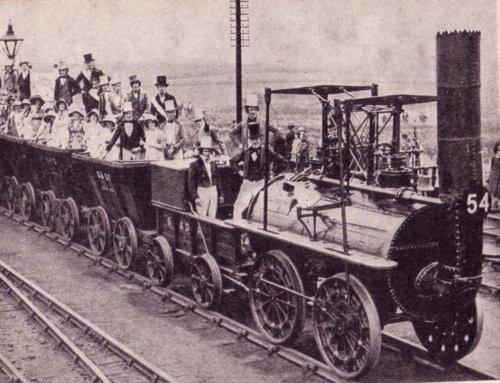
The catalyst for change was the building of the Liverpool &
Manchester Railway, intended to carry the raw cotton imported at Liverpool to
the water powered mills around Manchester. The building of this line required
an Act of Parliament and parliament was dominated by the conflicting interests
of various pressure groups. The British democratic political system was still
in its infancy, few people had the vote and rioting was not uncommon as a
method of protest. The Duke of Wellington was Prime Minister at the time and he
was generally opposed the building of railways as he felt it was politically
dangerous to enable large numbers of people to move about the country.
Rope haulage using large stationary steam engines beside the track was
seriously considered for the Liverpool & Manchester line however George
Stephenson (1781-1848), a respected railway engineer and a believer in the
steam locomotive, was hired as the Liverpool & Manchester Railway Company
chief engineer. Once the decision was taken to consider using steam locomotives
on at least part of the line the parliamentary debates on the Liverpool and
Manchester line became even more heated. Existing steam locomotives were
inefficient, using a lot of coal and producing a lot of smoke and soot which
people believed would poison the land and cause cows to stop giving milk. The
first attempt to obtain an Act for the Liverpool to Manchester line failed
largely because a certain Duke thought the line would upset his fox hunting
(research in the 1940's showed that a steam railway actually had less impact on
wildlife than a well used footpath).
Respected scientists testified
that people would be unable to breath at the high speeds (perhaps more than
thirty miles per hour) suggested by the engineers. Partly due to Stephenson's
enthusiasm for steam locomotives the Liverpool and Manchester Railway company
staged a series of competitive engine trials at Rainhill in 1829. One entry was
horse powered and another was operated by two men and a hand-crank but all the
rest were all variations on the new steam locomotives of the time.
It
was for this competition that the famous locomotive Rocket was built by George
Stephenson's son Robert Stephenson. The Rocket featured efficient cylinders (made using a recently developed boring technology) and
a multi-tube boiler that increased the heating area dramatically, it won the trials and demonstrated the potential power of steam locomotives.
Fig___ The Rocket of 1830
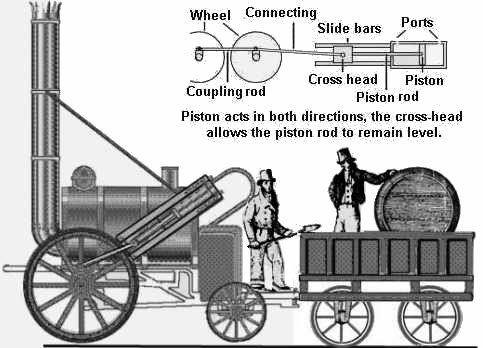
Essentially similar locomotives were ordered by the
railway company, which opened for passenger traffic in September 1830 as the
first all-steam hauled passenger and general goods railway and also the first
inter-city line in the world. Very quickly an 0-4-0 wheel arrangement was adopted (notably for freight engines) providing greater traction although with a lower top speed.
Fig___ Early 0-4-0 freight locomotive
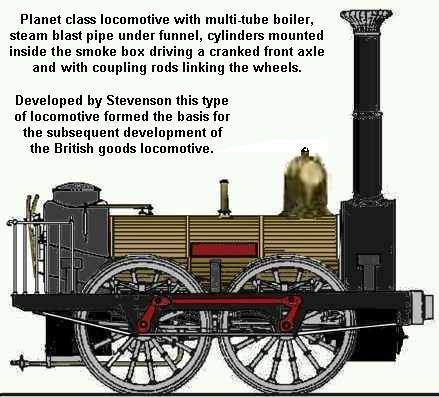
The Liverpool & Manchester Railway company
introduced the double-track which is so characteristic of British lines and
arguably more than any other encouraged experiment and so facilitated the rapid
development of railway systems.
The line was actually
built to transport the thousands of tons of materials shipped each year from
the port of Liverpool to the mills and factories of Manchester. The first goods
train passed down the L&M line in December of 1830, the locomotive 'Planet'
hauling about eighty tons of goods over the thirty one miles (48 km) in less
than three hours. The goods hauled by Planet were bulky and this was the
equivalent of three barge-loads which would have taken 36 hours to complete the
journey. There is a sketch of the Planet in Appendix Four - Locomotives and DMUs - Overview and General Information
The L&M railway lines were soon extended through Liverpool to the
docks and there up to twenty goods trains a day running each way on the line.
Despite the early shortage of locomotives by the mid 1830's there were over two
hundred thousand tons of general goods and a further hundred and some odd
thousand tons of coal being moved on this line each year.
For a sense of the scale of the operation the Manchester Liverpool Road station is described in some detail on the Disused Stations web site. Thanks are due to Dennis Markuss for pointing this out.
Passengers
were expected to be relatively few in number but in the event there were soon
over a thousand passengers a day travelling along the line and that figure had
doubled by the end of 1831. For some time the total money earned from passenger
trains was greater than from goods, although the profit margin on passenger
receipts was smaller than that for goods traffic.
Fig___ 1830s railway booking hall (Manchester)
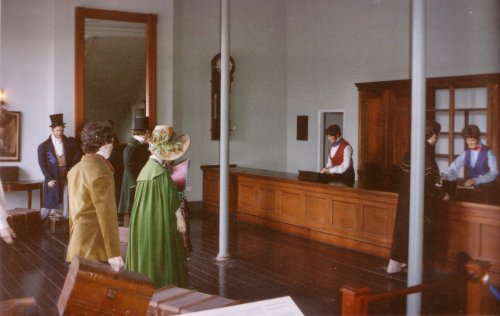
This unexpected demand for
passenger travel was seen on all the early railways and the prestige due to
popularity of the railways with the travelling public proved to be a benefit
when dealing with parliament.
Within a few years passenger fares
amounted to over two million pounds per year. Goods receipts were more than
twice that figure, and provided a greater return on invested capital, but
drivers of goods and luggage trains were still instructed to leave the line
clear for passenger trains, 'by shunting if necessary'.
The Liverpool
& Manchester railway company built up a stock of about 400 wagons in
addition to which various users operated privately owned stock. The single
largest contribution to goods tonnage was naturally coal, at the Manchester end
of the line bottom-discharging hopper wagons of the chauldron type were used
emptying into excavated drops. The Chaldron is a measure not a weight, corresponding to 36 bushels, 864 gallons, 139 cu feet or just under 4 cu metres, and equates to roughly three tons of coal. The chauldron was the legal limit for horse drawn coal road waggons heading for London as it was felt that heavier loads would cause too much damage to the roads. The railway chauldron wagons were about ten feet long and about six feet three inches high and featured a very short wheel base ranging from about four feet six inches to about six feet. The short wheelbase, a hangover from their colliery origins, enabled them to be used on extremely tight curves and the same general design
continued in use up to the 1970's on colliery lines in the North East. In
Liverpool wooden coal containers called 'skips' were carried on 'skeliton
wagons' (sic - a simple chassis with no body) and were craned onto road wagons
for delivery. The container wagon has two sets of buffers as the chauldrons buffers were lower down and closer together than on standard rolling stock so some wagons had the extra set to run with them.
Fig___ L&M Rly. 'chauldron and coal container wagons
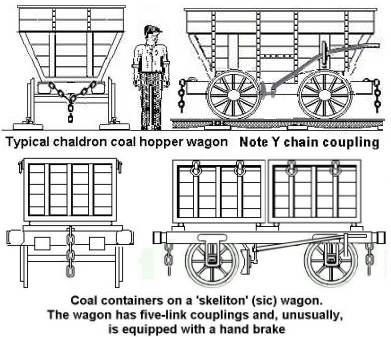
The coal containers or 'skips' were by no means a new idea even
in 1831, they had been in use in collieries for over a hundred years and the
nearby Bridgwater canal routinely used them for transporting coal in barges.
The coal containers were not a great success on the L & M but proved
popular on other lines and have remained in service in one form or another to
the present day. Pickfords the road haulage contractors built some general
merchandise containers in the early 1830's and these remained in service for
many years. Large purpose-built terminals were provided to transfer these
general merchandise containers from the railway to horse drawn carts.
Pickfords started out in the road
haulage business in a town called Poynton in Cheshire in the 1740's, and were
by this time a well established company. They had moved their headquarters to
London in about 1823 (the last family member connected with the firm died in
1846). As well as road carts and wagons they owned a fleet of canal boats and
it is believed that their logo in this era was a vertical white diamond shape
on a dark blue or black background. This logo was painted on the canal boats
and was probably applied to the containers but I have not managed to find any
illustrations that show its placement.
Fig___ Cross section of
1830's Pickfords container terminal
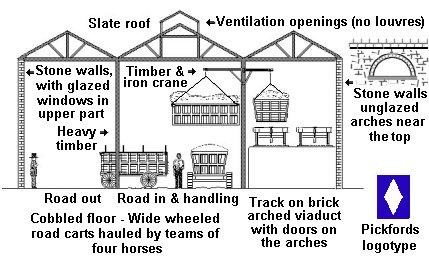
Container traffic on the railways is
discussed more fully in the section on Unit Loads on the Railways.
Initially railways were seen as being essentially similar to roads and
canals, a 'road' on which independent contractors could haul trains of goods,
and this way of working was not uncommon in the first years of the Nineteenth
Century. Things went fairly well in the era of horse and cable haulage but
after a series of mishaps all locomotive hauled trains had by law to be pulled
by Railway Company locomotives. Private railways such as those operated by
collieries were allowed to operate their own locomotives but these would not be
allowed to venture out onto the railway system proper.
Following the
lead set by the canals ownership of railway goods rolling stock has always been
divided between the railway companies and Private Owners (usually abbreviated
to PO). A few of the early railway companies actually owned no stock at all,
everything being carried in private owner wagons. The Liverpool &
Manchester Railway was initially intended to operate as a 'highway' on which
private contractors could operate their own trains, this state of affairs did
not last for long however and by 1834 the company had bought out all the
private passenger coach operators. This meant that the company had to invest a
lot of capital in the railway rolling stock. Allowing privately owned goods
vehicles meant that other peoples money was used to build and maintain these
and privately owned goods wagons do not incur rental charges for the user. A PO
wagon can therefore serve not only for transport but also for storage on the
users own siding. PO wagons have remained a feature of the British system up to
the present day.
The railway system of charging evolved based on
experience, no one had operated a railway before and the system became ever
more complicated (see also Historical Background - Charging for goods on the
railways).
Goods shipped in
open wagons were subject to weather damage but the high speeds meant this was
less of a problem than with other forms of transport. A new threat however was
fire, the early locomotives used coke rather than coal and the simple boiler
designs meant that sparks and glowing embers were often blown out of the
chimney. The fire grates under the boiler were not enclosed and red hot or
burning embers fell from the simple fire grates onto the track. One early
passenger wrote enthusiastically of being "drawn along as though in the tail of
a comet". A lot of the traffic on the Liverpool & Manchester Railway was
bales of cotton and after several fires the company engineer George Stephenson
advised that heavy canvass should be used to cover all loads for protection.
This did not stop the wagon fires caused by embers on the track being caught up
in the wagon wheels and whirled round but it was a couple of years before all
locomotives were fitted with ash pans. The open wagon with the canvas tarpaulin
cover, or 'tilt' as they were often called, remained the principal method of
goods transport for over a century.
The success of the steam hauled
Liverpool and Manchester Railway prompted the building of new lines around the
country. The Grand Junction Railway opened in 1837, running from Birmingham to
Warrington, where it connected with the Liverpool & Manchester Railway
becoming the first railway trunk route in the world. A year later the London
& Birmingham railway started operations, completing the link to the
capital. The early railways were generally successful, they survived the
industrial depression of the early 1840's and in the following years there was
a boom in railway development, partly encouraged by the fortunes made by the
people who had invested in the early canals and waterways.
By the late
1840's the era of experimentation on the railways was over, the lessons learned
in Britain enabled other countries to build their systems with much less
confusion and trouble. Over the next sixty years virtually all the railways in
the world were built, most using the same gauge track as the Liverpool and
Manchester. The building of the railways around the world was the largest
single task ever undertaken by humanity, the equivalent of building several
thousand copies of the Great Wall of China.
The relative high speed of
the railways allowed perishables to be carried from the country to the large
towns and by the late 1840's London was receiving over seventy tons of fresh
fish a week from the ports of Yarmouth and Lowestoft courtesy of the Eastern
Counties Railway. The railways involvement with the fish trade is discussed in
under Freight Operations in the subsection dealing with Non Passenger Coaching
Stock Operations. Natural materials used for dyes were a profitable cargo for
the railways, imported vegetable matter such as Madders, Indigo and Safflower
were moved in considerable quantities (up to the 1880's when synthetics took
over).
The average length of a British railway company line at this
time was in the region of fifteen miles and it was inevitable that lines began
to consolidate and merge, establishing larger and more efficient companies
covering much larger geographical areas. For example in 1846 the Liverpool
& Manchester, the London & Birmingham, the Grand Junction Railway and
the Manchester & Birmingham amalgamated to become the London & North
Western Railway (LNWR), which thereafter titled itself the 'Premier Line'.
By his time the railways had become a vital part of the nations
economy, fears of the power wielded by the railway companies lead to the
'common carriers' legislation (see also Historical Background - The Common User Scheme) and even calls
for nationalisation of the British network. The railway companies, with the
rather dubious railway magnate George Hudson (1800-1871) as their spokesman,
did not want unrestrained competition which they felt would be ruinous (the
American experience suggested there was truth in this contention). Hudson
pressed for a middle course based on a potentially highly profitable 'regulated
monopoly' and in this he was moderately successful.
In 1844 a separate
Railway Department was formed at the Board of Trade, ostensibly to look at the
relative merits of various proposed railways and mergers of existing lines. In
the event the fear of monopoly meant that a great many railways were built with
little regard for how competition would affect their fortunes and several major
trunk routes were duplicated or even triplicated. In mainland Europe the state
exercised greater control over the railways in order to establish orderly
strategic networks. Belgium, which had gained its independence from Holland in
1830, saw a National Railway as a vital component of its national identity and
the network was sponsored by the government. In France no tracks were laid
until the Government had devised a strategic system based on Paris, in the
1840's four regional companies were established, each with a ninety nine year
lease on their territory and the legislation discouraged competition between
the lines (the four railways were amalgamated in the mid 1930's to form the
national railway operator SNCF). In the fragmented collection of small
semi-independent states that later became Germany there was a real need for a
military strategic railway network and little alternative to State funding.
In Britain the Railway Department of the Board of Trade encouraged the
process of standardisation, mainly with regard to safety systems and signals.
The railway companies were by now very powerful organisations, Parliament at
the time was dominated not by party politics but by interest groups and the
Railways were amongst the most powerful of these. As a result most of the
Railway Departments rules were only applicable to lines and installations built
after the rules were drawn up, few changes were forced to existing systems.
In the 1840's, 50's and 60's there were a series of commissions on the
Railways, all seeking to establish some means of avoiding a monopoly whilst
allowing the railways to work efficiently. One change introduced in the 1850's
was the banning the railways from granting special privileges to individuals (a
method used to 'buy off' the objections of rich land owners and competitors).
In 1867 the Commission on the Railways reported that there were close to two
thousand pieces of legislation now in force relating to railways and another
fifteen hundred or so which contained amendments or modifying clauses. Given
the complexity of this legislation, and the fact that it contained many
contradictions, they concluded it was practically impossible to sort out what
the legal duties and responsibilities of any particular railway might now be.
In 1863 the first of the London underground lines opened from
Farringdon to Paddington, this was the worlds first underground railway. The
concept had been championed by a man called Charles Pearson who was Solicitor
for the City of London. Mr Pearson's plan for trains running in drain-like
tubes was ridiculed by Henry Mayhew, the author of The London Poor and the
founder of Punch magazine. Punch ran a series of articles suggesting ways that
various coal cellars and the like might be used as part of the route to save
money.
The line was built and the MP Mr. Gladstone travelled on first
train with his wife but Mr. Pearson had died six months beforehand. In 1863
three quarters of a million people went to work in London and the new
underground railway was to prove a great success. The steam trains represented
a problem when running in long tunnels as the steam and fumes from the boiler
would suffocate the passengers. The original solution was to route the steam
into tanks on the locomotive which could be opened to release the steam as the
train passed under large ventilating openings. A later and more successful
approach was to feed the steam into condensers and return the condensed water
to the boiler feed tank on the engine. The tank engines fitted with this
equipment can be identified as they have large diameter pipes visible on top of
the side mounted water tanks.
Fig___ Underground railway 'condensing' engine
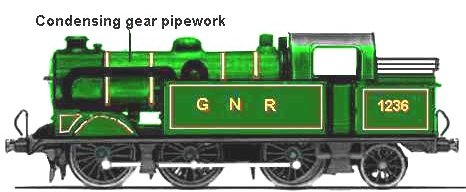
The introduction of the first Bank Holiday in 1871, along with other traditional holidays taken by factory workers, saw an increase in interest in day's away by train, usually to a seaside destination.
The Midland Railway, a late comer in the
railway world, had rather longer routes and had to compete for passengers by
offering greater comfort and amenities. The Midland was noted for its eagerness to promote its lines for tourism. In the 1870's they brought in some
American 'Pullman' coaches, these had no compartments and passengers could move
from one coach to another via the small boarding platforms at the ends. Dining
cars appeared in Britain on the Great Northern Railway in 1879, but these had
no connecting doors so the clientele remained in the coach for the entire
journey or moved when the train stopped at a station.
In 1881 concern
over the spiritual welfare of the railway staff, many of whom spent much of
their time away from home, prompted the formation of the Railway Chaplaincy.
The force behind this was a remarkable lady by the name of Emma Saunders who
had been working to provide the railway staff with moral and social support
since the 1860's. This was a time of increasing interest in evangelical
Christianity and Mrs. Saunders, know by this time as 'the railway mans friend',
gained the backing of Lord Shafstbury, a major force in social reform. The
Railway Chaplains still travel the system today giving spiritual support to
railway personnel and passengers. They can be requested by a particular staff
member at any time and they will travel through the system to meet the person
wherever it is they may be. The Chaplains are interdenominational and are drawn
from many Protestant churches, they do not these days wear the clerical 'dog
collar' but they carry an identity tag on their lapel to identify them to
staff.
In 1884 Gladstone, by now the Minister of Transport, headed a
Select Committee to review the development of the railway system. On the
continent there was much more state involvement and there was talk at the time
of the British government entering into a partnership with the railways (as had
been done in France) or even of complete nationalisation. In the event nothing
much happened at the time. In 1886-87 a Royal Commission on Railways looked at
the question of regulating Britain's railway network again and although
Gladstone's ideas on partial nationalisation were considered they were in the
event rejected. It was decided that a recent law, entitling people to claim
compensation for loss or injury on the railway was sufficient to protect the
interests of the public and that the Board of Trade should not directly
interfere in the running of railway companies.
The 1888 Railway and
Canal Traffic Act represented the growing realisation that the nation's
railways were a strategic and economic asset of unrivalled importance. The
Railway and Canal Commission was made a permanent body and given stronger
powers whilst the Board of Trade was appointed to act as an impartial
arbitrator between the railway companies and people who felt they had a
grievance.
Also in 1888 the first 'slip coaches' appeared on the London
Brighton and South Coast Railway, the South Western Railway and the Great
Western Railway. These coaches had their own brakes and could be detached from
the rear of a train while it was moving, allowing them to be 'dropped off' as
the train passed through a station.
In spite of various accidents
during the 1870's the railway companies had resisted Government attempts to
introduce more sophisticated brakes on passenger trains. This was partly
because of cost but also they were unable to agree on a standard system.
Following a serious accident in Ireland in which 80 people died, many of them
children, automatic continuous brakes became mandatory on passenger stock in
1889. Automatic means that if the train parts the brakes on both sections will
automatically be applied and continuous means that all the vehicles brakes can
be controlled from a single point, usually the engine. Rolling stock equipped
with this kind of brake is usually described as 'fitted', vehicles with only a
hand brake are described as 'unfitted'.
There were many different
designs for brakes (these are discussed in the section on Rolling Stock
Development) in Britain most companies opted for the vacuum operated automatic
brake systems, usually abbreviated to AVB. The use of continuous brakes allows
higher speeds and it was not long before such brakes appeared on high speed
goods stock such as cattle wagons, fruit vans and fish trucks, allowing these
to travel attached to passenger trains. Most goods wagons remained
'unfitted' and goods trains trundled about at 25 to 30 m.p.h.
The first electric trains on the London Underground railway system
appeared on the City & South London Railway of 1890 and the inner London
underground system was fully electrified by 1905.
Fig___ Early London Underground Electric Locomotives
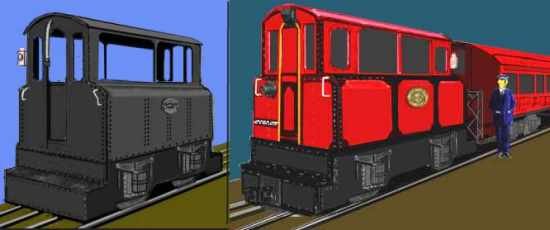
Services in the outer areas
of the system remained steam hauled and some of these steam services lasted
into the British Railways era.
In 1895 an act of parliament allowed the
setting up of 'Light Railways', this was in part an attempt to help the rural
farmers compete in the new national market supplied with cheap imported food.
The light railway was not bound by the same regulations as the larger main line
companies and so cost less to operate, but the speed on such lines was
restricted to a 25 mph (40 kph) and the maximum load was about ten tons per
wagon. Not all light railways were operated by minor companies, some lesser
branch lines of the larger concerns had originally been granted their Act of
Parliament for goods traffic only. Some of these goods-only branches were
granted the right to carry passengers under light railway orders. This means
you can have a branch line on your layout which uses older and lighter
locomotives, older carriages and carries regular goods traffic.
The
last Light Railway to operate in the UK was (I believe) the Derwent Valley
Light Railway which opened in 1913 and closed down in the later 1980's having
remained independent throughout it's existence. There are some useful photos of
this line taken in the 1970's in the book British Railway Goods Wagons in
Colour by Robert Hendry (Midland Publishing ISBN 9781857800944).
Light
Railways generally had lower platforms than the main line companies and some
arranged stops at the level crossings on the line, this was one reason so many
early lines had footboards on their carriages. The larger railways companies
then tried the same idea, fitting local coaches with fold down steps to allow
passengers to board at level crossings. This was not considered a success,
Humphrey Household's book Gloucestershire Railways in the Twenties (published
by Alan Sutton in 1984, ISBN 0862991978) suggests that after trying this
approach on their steam rail-motor coach units in about 1900-1903 the GWR
switched to building short wooden platforms and in so doing introduced the word
Halt to describe them.
It is perhaps worth noting that at the end of
the nineteenth century there were about fifteen hundred miles (2,400 km) of
horse-hauled wagon ways still operating in Britain.
There were a number
of narrow gauge lines in the country, many of which operated as light railways.
The problem faced by these lines was the transhipment of goods to and from
standard gauge stock. One company, the Leek & Manifold Light Railway solved
this problem by building transporter wagons. These had 'foot boards'
to either side fitted with rails to carry standard gauge wagons. The London
& North Western Railway and the Great Western Railway, both of whom
operated services into the slate producing areas of North Wales, built standard
gauge transporter wagons so the loaded narrow gauge slate trucks could be
carried to the docks without transhipment.
By 1900 the British railway
system was virtually complete, the last major trunk route was the Great
Central's London Extension to the new Marylebone terminus in 1889, but that
venture probably never paid for itself. The Great Central had decided to run
its own line into London having had problems with its running arrangements with
both the LNWR and the GNR for access to the capital, arrangements which had
earned the nickname 'the flirtatious railway'. Closed cabs were standard on new
locomotives, some of the older designs in the ready-to-run ranges date from
this era and other types can be modelled using the Graham Farish 0-6-0 tanks,
and possibly the 4-4-0 tender locomotive as a basis. Bogie coaches started to
appear in the early 1900's but the old four and six wheeled stock continued in
use.
By this time British railways were carrying about five hundred
million tons of coal a year (as opposed to about thirty five million tons in
1995) and the number of passengers carried each year in Britain alone was
roughly equivalent to the then population of the earth. Cattle were a regular
traffic for the railway companies, involving purpose built cattle wagons often
marshaled into an entire train. Milk from the country to the towns and cities
had been moved by rail from the 1870's and soon became a major traffic
flow. Initially the milk was not treated in any way, it was delivered to the
station in silver conical churns and carried in slat sided vans to the towns
(milk tanks appeared in the early 20th century carrying processed milk from
purpose built 'creameries' in the country). Long trains of purpose built fish
wagons and vans were being hauled from the fishing ports to the larger cities
by large express locomotives.
Fig___ British Railway Network
1900
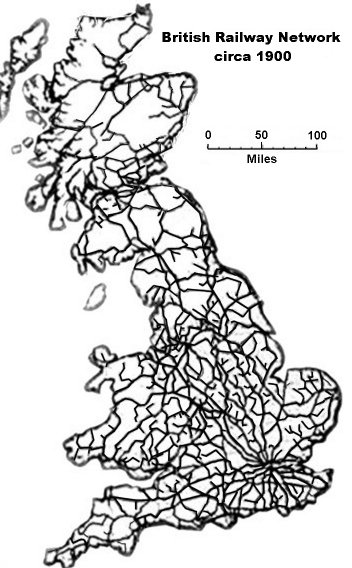
Branch lines continued to be laid into the early twentieth
century but there was very little development of the railway network after
about 1920. By this time the large numbers of petrol lorries, and men trained
to operate them, that had come onto the market after the First World War was
starting to impact on the railway freight business. Similarly motor-buses were
increasingly being used for local passenger transport, although these were less
comfortable than trains they were cheaper.
Click here for some notes on the heating and lighting
used on passenger trains.
In 1903 electrification of some
lines around Tyneside was begun using outside third rail pick-up. In 1904 the
Liverpool to Southport main line became the first British main line railway to
be electrified using an outside third rail carrying 600 volts DC.
Fig___ 1904 L&Y Railway EMU
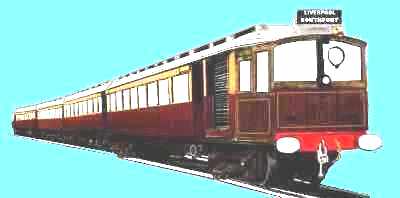
Pride
in service and company loyalty were very high amongst railway employees.
'Uniformed' positions meant staff did not have to buy their own working clothes
and it was a steady job which was highly valued. There had been a move toward
improving the lot of the railway employee since the 1890's, the railway workers
were the first men to have their hours regulated by the Board of Trade.
Meanwhile the effect of the continuing competition between companies was an
increase in the amalgamations. The Board of Trade intervened again in 1907 to
avert a strike and set up review boards for pay, but by 1911 a widespread
strike was unavoidable and involved most of the larger companies. This strike
was in part due to unfavourable settlements reached regarding pay and
conditions and partly due to the feeling that railways had always paid poorly
but offered security of employment. The series of amalgamations had lead to a
reduction in staff and even where redundancy did not follow promotion prospects
were blighted.
Express goods trains appeared in the early 1900's,
offering speeds in excess of 40 mph (64 kph). Rolling stock used in such trains
had to be fitted with oil filled axle boxes, at least a third of the wagons had
to be 'fitted' (equipped with automatic brakes) and private owner wagons were
not allowed.
Most general goods traffic was in the form of small
consignments although full wagon loads were sent from factories to other
factories or local distributors. Most bulk goods such as coal and oil were
moved by the wagon load rather than as a complete train of wagons. An entire
train carrying one consignment is called a 'block load' or 'block train' by the
railways. Block trains of coal were run from the mines to docks and to railway
yards where individual wagons would be sent off to merchants, gas works and
factories. A typical block coal train in this period would involve some fifty
or sixty wagons hauled along by a tank engine at maximum speeds of about 25 mph
(40 kph).
The domestic economy was based on the small corner shops and
a great deal of railway goods traffic was therefore made up of small
consignments being sent from one railway station to another for collection by a
local trader. Not infrequently a wagon or van would carry only a single
consignment to a local goods yard, for example half a dozen carpets, hardly a
'full load' for a ten ton van. Traders were given 48 hours to unload a wagon,
paying a fee if they took longer than this. The railway companies managed
something similar, unloading most wagons within a day of their arrival and
loading them up again within another day.
The railway companies advised
the Railway Clearing House (see also Historical Background - The Railway Clearing House) regarding wagon
movements on a daily basis, they had to return foreign companies rolling stock
within five days or pay a daily fee called 'demurrage'. It was seldom possible
to find a return load for a wagon hence there was a great deal of movement of
empty stock.
With the outbreak of the First World War the government
set up an organisation called the Railway Executive to co-ordinate control of
the railway system. Under this system the various companies were still largely
autonomous and overall the arrangement worked very well, about 130 railway
companies were involved and this centralised control lasted until 1921. One
major change introduced during this war was the which dramatically reduced the empty wagon mileage on the
system.
In 1913 the Lancashire and Yorkshire electrified the Bury to Holcombe Brook line at 3500 Volts DC using an overhead supply. Two two-car units were built for this line.
Lancashire and Yorkshire Rly Holcombe Brook EMU
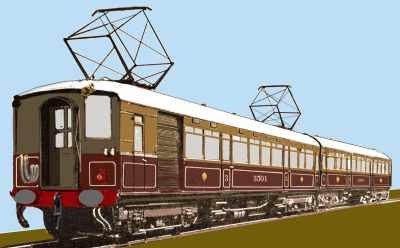
The First World War was a difficult time for the railways, many
of their staff were called up to fight whilst spares and other materials became
increasingly scarce. The general condition of most railway rolling stock
deteriorated during the war and the livery on passenger stock was sometimes
replaced with a plain overall colour (including khaki and black).
The
war brought home the importance of strategic industries and in 1920 the
Ministry of Transport was formed by the government. This new ministry charged
with co-ordinating the development of roads, railways and to a lesser extent
the canals and navigable rivers (legislation relating to deep-sea and coastal
shipping remained the province of the Board of Trade).
In 1921 the
Irish Free State was established giving full independence to the southern
counties of Ireland (implemented in 1922) and the 1921 Railway Act lead to the
1923 government sponsored rationalisation of the railway system known as 'The
Grouping'. This represented a major about face for the Government, they had
lived in dread of the power a railway monopoly would wield and had resisted
amalgamations which they felt would reduce competition. This policy had not
been entirely successful however and three large companies with effective
territorial monopolies had already formed themselves. The North Eastern Railway
was created by the amalgamation of three companies in 1854 giving it virtually
total control in Northumberland, North Yorkshire and Durham, the Great Eastern
Railway formed in 1862 gained unrivalled control of East Anglia, whilst in
Scotland the Scottish Central and the Scottish North Eastern had been absorbed
by the mighty Caledonian Railway.
Amalgamations had been allowed where
these did not threaten a monopoly, mainly smaller lines being absorbed or
leased by larger neighbours, but there remained a great many independent
companies. Scotland and Wales, late starters in the railway business, had both
been opened up by these smaller railway companies. There were also a great many
'Joint' lines, owned or operated by two or more larger companies.
The
`Grouping' of 1923 was in effect a government sponsored rationalisation of the
British railway system. About a hundred and twenty or so of the larger
independent railway companies were amalgamated into four large regional
concerns, subsequently generally referred to as `The Big Four'. These four were
the Great Western Railway (GWR), the Southern Railway (SR), the London North
Eastern Railway (LNER) and the London Midland and Scottish Railway (LMS).
The Big Four were based on geographical regions, LMS being the West of
England, North Wales and West of Scotland, LNER being the Eastern England and
Eastern Scotland, the SR worked the English South coast and the GWR covered the
West of England, South Wales and Cornwall. Naturally there was some overlap of
owned lines, and the provision of running powers on one companies lines for
another companies trains was not uncommon. The GWR and LMS had the strongest
financial position but the Southern Railway companies had been hard worked
during the 1914-18 War. In the East the Great Central and Great Eastern were
both in poor financial straits and even the relatively successful Great
Northern was not as well equipped as it might be. The LMS, LNER and SR were
largely new companies, deriving their operating practice and designs from the
larger absorbed companies. The GWR was slightly different, already a large
company, effectively absorbed all the smaller lines and stamped its identity on
them. The GWR, SR and LNER managed the transition with little administrative
difficulty but the LMS had some trouble dealing with rivalries between the
Midland Railway & the London and North Western Railway in England and
between the Glasgow & South Western Railway and the Caledonian Railway
North of the border .
Each of the new four companies inherited all the
various works built by their constituents but rationalisation concentrated work
at a small number of larger establishments. The main LMS works were at Crewe
and Derby, the LNER had extensive facilities at Doncaster and Darlington and
the SR had works at Ashford and Eastleigh. The GWR had its original massive
works at Swindon, which had been a small village before Brunel decided to use
it as his engineering centre. Each company inherited a number of routes to
London, the LMS operating into Euston and St Pancras, the LNER from Kings
Cross, Broad Street and Liverpool Street, the GWR from Paddington and
Marylebone, and the SR from Waterloo and Victoria.
There were three
large railway companies which had been jointly run before the grouping and
continued as such under the Big Four. Largest was the Cheshire Lines Committee,
linking Cheshire with Lancashire, which had been jointly owned by the Great
Central, Great Northern and Midland Railway. The CLC was unusual in that the
only engines it ever owned were four Sentinel passenger steam rail-cars. The
CLC could not be easily allocated to either the LMS or the LNER and continued
as a separate company jointly owned by these two new companies. A joint the
board of directors was formed, three from the LMS six from the LNER. The CLC
remained as the fifth largest railway company in the UK until Nationalisation
in 1948. In Cheshire after the grouping the CLC, LMS, LNER and GWR all had
lines and complex agreements allowing trains to operate on each others tracks.
From a goods point of view this is one of the more interesting areas in the
country.
The Midland & Great Northern Railway was another joint
operation, this time in Norfolk. Originally operated by the Midland (who
provided the locos and most of the rolling stock) and the Great Northern (who
dealt with the track, signals etc.). This became an LMS/LNER joint company
after the grouping.
The Somerset & Dorset Joint Railway, previously
worked by the London & South Western Railway and the Midland Railway became
an LMS/SR joint line.
The M&GN and S&DJR were both lines which
had a great deal of single track and distinctive operating practices, features
which remained until their closure in 1959 and 1967 respectively.
S&DJR goods rolling stock had been divided between the LSWR and the
MR in 1914, leaving only engineers vehicles, brake vans, the passenger stock
and some locomotives in S&DJR livery. The CLC goods rolling stock and the
remaining S&DJR stock was divided between the owning companies in 1930. The
M&GN rolling stock was divided in 1936, but on the CLC and M&GN the
brake vans and service vehicles remained the property of the joint companies
for some years afterward. Brake vans in CLC livery were still seen around the
country in the 1950's, usually attached to Eastern Region trains.
In
areas such as the Forest of Dean the complicated working arrangements between
the Great Western and Midland Railways on the Severn and Wye Railway were
continued by the new GWR and LMS companies.
As well as the 'Big Four'
and the joint companies there remained a few other independent lines, mainly
'Light Railways'. These continued to operate into the 1930's when economic
conditions forced most into bankruptcy. From a modelling point of view these
would more closely resemble the pre-grouping period in locomotives and coaching
stock. Most goods traffic on these lines travelled in the larger companies
rolling stock.
A summary of the larger constituents of the Big Four is
of use to the modeller as it tells you whether a pre-grouping model can be used
in your preferred company livery. For example the Graham Farish Fish van is a
Great Northern Railway design, which is therefore legitimate in LNER livery. It
is standard practice to define periods in a companies history by the name of
the Chief Mechanical Engineer, or CME. I have included the relevant names and
dates under the company title.
London
Midland & Scottish Railway (LMS)
Fig___ The LMS system
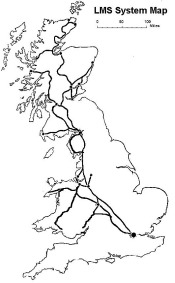
CME's: G. Hughes
(who had been CME of the Lancashire & Yorkshire, subsequently the LNWR
since 1904) 1923 to 1925. Sir H. Fowler (came from the MR, where he became CME
in 1903) 1925 to 1931. Sir W. Stanier 1931 to 1944. H. G. Ivatt 1945-1947
Comprised of the Midland Railway (including the London Tilbury &
Southend absorbed in 1912, some narrow gauge lines and some lines in Northern
Ireland), the London & North Western Railway (including the Lancashire
& Yorkshire, absorbed in 1921, the North London Railway absorbed in 1909),
the North Staffordshire Railway (including the narrow-gauge Leek & Manifold
Valley Railway), the Caledonian Railway, Cleator & Workington Railway,
Maryport & Carslile Railway, Garstang & Knott End Railway, the Wirral
Railway, the Stratford on Avon & Midland Junction Railway the Furness
Railway and the Highland Railway.
The LMS also inherited an interest in
certain jointly owned or operated lines such as the Cheshire Lines Committee
and the Midland & Great Northern with the LNER, the Severn & Wye
Railway (operating in the Forest of Dean) with the GWR, and the Somerset &
Dorset Joint Rly. with the Southern (the goods stock of this latter company
being divided between the two in 1930, at which time much of it was still in
S&DJR livery).
London & North Eastern Railway
(LNER)
Fig___ The LNER system
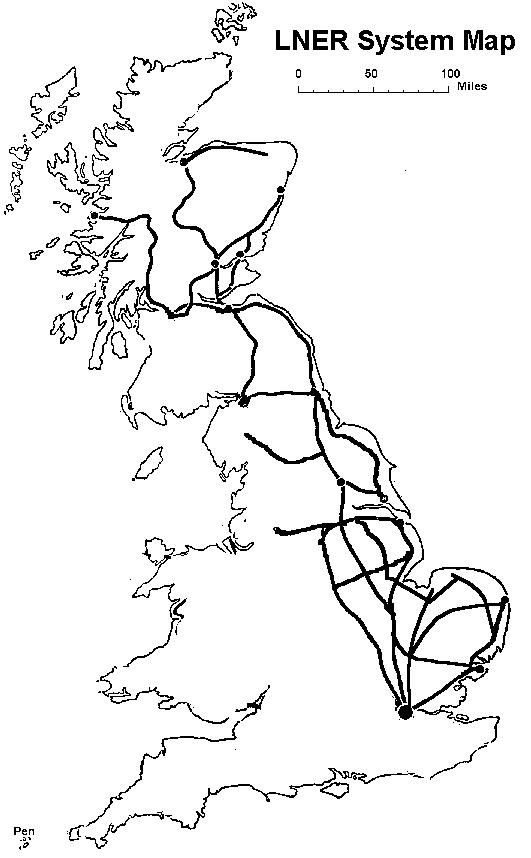
CME's: Sir N. Gresley (CME of the G.N.R
from 1911 to 1922) 1923 to 1941. E. Thompson 1941 to 1946. A. H. Peppercorn
1946 to 1947.
Comprised of the North British Railway, Great Central
Railway (called the Manchester Sheffield & Lincolnshire Railway until 1897
and including the Lancashire, Derbyshire & East Coast Railway absorbed in
1907 and the Wrexham Mold & Connah's Quay Railway absorbed in 1905), Great
Northern Railway, North Eastern Railway (including the Hull & Barnsley
Railway, absorbed in 1922), Great Eastern Railway, Great North of Scotland
Railway, East & West Yorkshire Union Railway, The Colne Valley &
Halstead Railway and the standard gauge Mid Suffolk Light Railway.
There were 20 or so smaller companies and the LNER inherited interests
in certain jointly owned systems, such as the Midland & Great Northern and
the Cheshire Lines Committee, both with the LMS.
Southern Railway (SR)
Fig___ The SR system
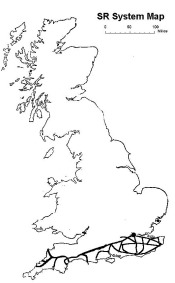
CME's: R. E. L. Maunsel (CME of the
S.E.C.R. from 1913) 1923 to 1937. O. V. Bulleid (who had been the assistant to
the LNER's Gresley) 1937 to 1947.
Comprised of London & South
Western Railway, the Isle of Wight Railway, the Isle of Wight Central Railway,
the Freshwater Yarmouth and Newport Railway, the South East & Chatham
Railway (formed in 1899 by the amalgamation of the South Eastern Rly & the
South East & Chatham Rly), the London Brighton and South Coast Railway and
the Plymouth Devonport & South Western Junction Railway. There were several
smaller companies such as the narrow gauge Lynton and Barnstaple Rly. The SR
also jointly operated the Somerset & Dorset Joint Rly. with the LMS up to
1930 at which time the SR took over operations on this single line route and
the stock was divided between the two grouped companies.
Great Western Railway
(GWR)
Fig___ The post-grouping GWR
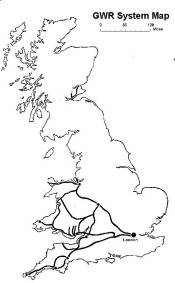
CME's: William Dean 1877 to
1902. G. J. Churchward 1902 to 1921. C. B. Collet 1921 to 1941. F. W.
Hawksworth 1941 to 1948.
Comprising the original Great Western Railway
(including the Liskard & Looe Railway absorbed in 1909) to which existing
large network was added several lines in South Wales: The Cambrian Railways
(including the Mawddy Railway), Alexandra (Newport & South Wales) Docks
& Railway Co, the Neath & Brecon Railway, the Rhondda & Swansea Bay
Railway, Burry Port & Gwendraeth Railway, the separate Gwendraeth Valley
Railway, the Llanelly & Mynydd Mawr Railway, the Cardiff Railway, Taff Vale
Railway, Barry Railway and Rhymney Railway. Other constituents included the
Midland & South Western Junction Railway, the South Devon Railway, the
Bristol & Exeter Railway, the Cleobury Mortimer & Ditton Priors Railway
and the West Midland Railway. There were also assorted smaller concerns
including the narrow gauge Welshpool & Llanfair Railway and the Vale of
Rheidol Rly. The GWR was also involved with various joint ownership
arrangements, such as the Forest of Dean railway system with the Midland
Railway, subsequently the LMS and various lines in Cheshire with the LMS and
LNER.
The Vale of Rheidol Railway was allocated to London Midland
Region after Nationalisation and was for a time the only British Railways steam
line. Diesels were introduced for service trains and shunting duties in the
1980's. The VOR was sold to Brecon Mountain Railway in 1988.
With all these companies goods
rolling stock was normally re-painted only as and when it came in for repair,
hence it was possible to see pre-grouping liveries in use on the railways right
up until the outbreak of World War 2 in 1939, rare examples have been reported
as late as 1948.
The 1921 Act also revised the charges for railway
goods traffic, the idea being to simplify what had become an extremely complex
business, this was not entirely successful however. The railway companies were
by this time looking at road transport as a possible avenue of expansion, the
Government ever fearful of monopolies introduced clauses in the 1921 Act which
hindered this line of investment.
During the First World War the War Department built three ships to carry railway vehicles and established military ports equipped with the necessary docking gear. In 1924 the LNER purchased the three ships and the associated shore 'link-span' equipment from the army, establishing the semi autonomous Great Eastern Train Ferries Ltd. to operate a service from Harwich to Zeebruge in Holland.
Fig ___ LNER (ex WD) train ferry
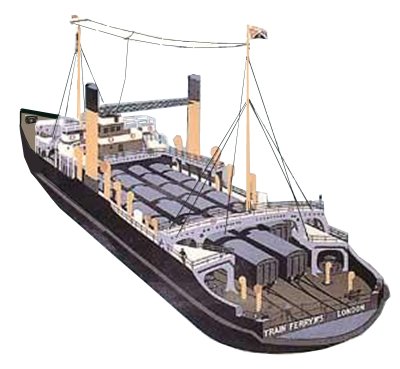
In about 1926 the railways began
offering door-to-door container services, the containers being transported on
both horse drawn and motor road vehicles at either end of their journey.
Fig___ 3 ton mechanical horse transporting a container
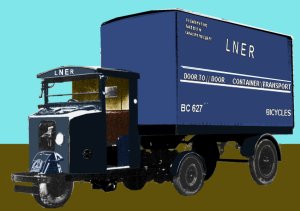
In the deepening recession of the early 1930's the government provided
cash, in the form of low interest loans, to assist the railways and canals with
redeveloping their infrastructure. These loans were used to subsidise several
major improvements to canals, notably on the Grand Union Canal. On the railway
side they were of greatest help to the Southern Railway and the Great Western
Railway, the LMS and more particularly the LNER were not in a strong enough
financial position to make much use of them. This period saw most of the
remaining 'light railways' fail, including several of the Welsh narrow gauge
lines built for slate traffic, a trade which had been in decline for some
years.
It was during the 1930's that the railways began to adopt a more
co-co-ordinated policy for handling goods traffic. Common shared depots were
established and traffic was shared and routed to form more cost-effective heavy
trains. This 'pooling' system reduced the number of smaller goods trains
competing not only with each other but also with the growing force of road
transport.
In 1936, the Southern Railway company and the newly nationalised French railway (SNCF) invested in new train ferry docks at Dover and Dunkerque. This service employed three ships each of which could carry twelve international sleeping carriages or twenty four forty foot wagons and an enclosed upper deck had a garage for 25 motor cars. The illustration below is based on a poster produced by the SR advertising this service. Note the funnels are mounted fore and aft rather than at the sides as on the old WD ferries.
Fig ___ 1930s Southern Railway train ferry
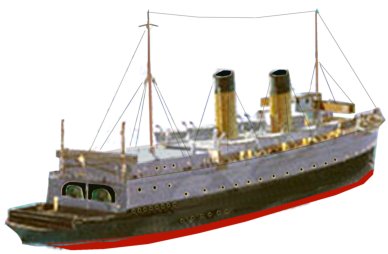
By the late 1930's the canal system was in decline but the
railway system, although suffering from road competition was looking quite
efficient. One new trade for the railways was in 'ferry wagons', railway wagons
fitted with securing points to allow them to travel on cross channel ferries or
across the North Sea. The first train ferries had been introduced by the
military in World War One, one former military service between Calais and
Harwich was maintained after the war and additional services soon followed. The
Portuguese were amongst the first to use this system, shipping perishables via
France in special vans with interchangeable axles to suit the standard British
and French and somewhat wider Portuguese tracks. Most goods continued to arrive
in conventional cargo ships however and all docks of any size, and most of the
smaller ones as well, were laced with railway lines.
In 1938 the rivalry between the LNER and the LMS for having the fastest passenger services saw the LNER A4 locomotive Mallard set a world speed record for steam traction of 126 mph (203 kph) in 1938 as it ran down Stoke Bank with a full load of passenger coaches in tow. The photograph shows a model of this engine in its post war British Railways livery.
Mallard

Photo of model courtesy Ian and Sandra Franz
Rearmament in the
later 1930's brought much needed revenue to the railways. In 1939 new passenger
rolling stock for the electrified the Liverpool to Southport line featured
sliding doors, these were the first sliding doors on non-underground stock and
they were not seen again on British coaches until the electrification of the
Glasgow Underground in 1960.
On the outbreak of war in 1939 the
government formally took control of the entire rail network, including the
separate London Transport system and several smaller railways. The general
managers of the Big Four and London Transport were set up as the Railway
Executive Committee to co-ordinate and control the whole railway system. The
railway companies were prepared and the transition to a war footing went
smoothly.
Freight operations increased steadily, stations near military
establishments were suddenly handling ten times the normal quantity of goods,
and by the late 1940 's overall freight tonnage was up by something like fifty
per cent on the pre-war norm. The war naturally brought changes in the traffic,
rolling stock had to be found for these new demands and this often involved
modifications to rolling stock which might be of interest to modellers.
Wartime conversions to goods stock
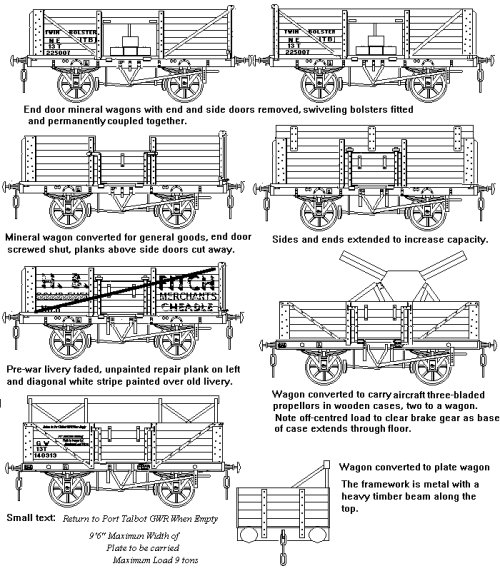
During this period all the private owner coal and iron ore wagons were
requisitioned and pooled. These wagons could then be seen in any part of the
country. Those with end-doors (Lima & Minitrix) had a diagonal white line,
rising to the end with the door, painted over their original private owner
livery (see Fig___). Private owner wagons for specialised cargo such as salt
and lime was not pooled and nor were the private owner tank wagons.
In
the mid 1940's some additional rolling stock was built, including some 10,000
end-door mineral wagons with steel bodies. Many of these were rebuilds on
existing nine foot wheel base chassis but the design formed the basis for the
post war British Railways standard sixteen ton mineral wagon.
The
railways had a difficult war, the blitz (German bombers raiding cities at
night) caused a lot of damage and locomotives and rolling stock was hard used.
With many of the railway staff in the armed forces, and railway workshops being
used for munitions work, maintenance fell behind. By the end of the war the
railway system was in a generally poor condition, the number of damaged
vehicles waiting for repair had increased by over 60% on the 1939 level. To
compound the problems faced by the railways the government, virtually
bankrupted by the war, was unable to keep its pre-war promise to pay the
railway companies compensation equivalent to moderately successful peace time
year.
Post war nationalisation of the railways was partly a Labour
Party dogma but it was probably unavoidable on economic grounds. The country
had taken a pounding during the war years and the economy was stretched to
breaking point. Railways are capital intensive, that is they require a very
large amount of money to operate at all, they were not providing a very good
return on investment and it is unlikely that investors would have seen the war
weary British railway companies as a worthwhile option. The railway companies
resisted nationalisation but they had little money and the Labour government
was committed. The 1947 Transport Act nationalised the railways, the canals,
the docks and a large proportion of the road transportation systems under the
new British Transport Commission. The thinking behind the structure was based
on the work done by Lord Morrison in forming London Transport; the plan called
for a properly co-ordinated public transport system and it was also intended to
integrate road and rail freight haulage.
London Transport remained a
separate entity but British Railways came into existence on the 1 June 1948,
inheriting a system with about 20,000 route miles of track, serving nearly
seven thousand passenger stations of which nearly five thousand had goods
facilities and a further fifteen hundred pure goods depots. They got about
twenty thousand assorted steam locomotives, only about fifty diesel engined
machines (shunting engines and a few GWR and LMS motor rail-cars) and sixteen electric
locomotives (not including the various passenger electric
multiple units operating in London and on the Southern Railway, in the North East and North West). There were at the time over six thousand private sidings on the
railway system feeding every kind of industry as well as extensive services
into the docks.
As well as the railway infrastructure British Railways inherited all the assets of the Big Four companies, one important asset was the fleet of ferries, including those carrying railway goods and passenger stock. These became 'Sealink' and remained under railway control for the next thirty years.
Fig___ Sealink cross-channel passenger ferry
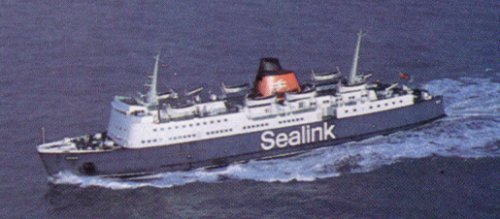
Also many of the larger hotels in the country were railway owned and became part of British Transport Hotels (these remained as part of the system until the 1980s).
Fig___ Turnberry - One of the large railway hotels
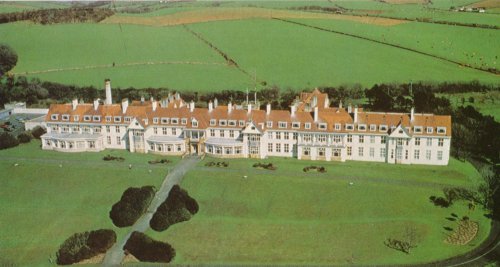
The wartime Railway Executive was replaced by a joint
British Transport Commission, with responsibility for British Railways, the
British Waterways Board (dealing with the inland waterways, rivers and canals) and the nationalised road
haulage organisation called the Road Transport Executive or RTE. The operating
arm of the RTE was British Road Services, who painted their lorries red and
their parcels vans green.
Note - Ken Ward, a regular on uk.railways newsgroup advised that the official colours for BRS were: General Haulage - Red, Vans - Green, Meat - Cream, Special Traffic (eg tipper lorries) - Blue.
The BTC was most concerned with the dire state of the
railways and in the event the idea of actually co-ordinating all the various
forms of transport into an integrated system proved too difficult to achieve.
The first British Railways 'crimson and cream' liveried passenger
coaches appeared in 1948. There was still a lot of suspicion amongst railway
workers and various railway workshops suddenly found they had stocks of the old
paint, which of course had to be used up, so coaches and locomotives were still
turned out in pre-war colours for the first couple of years.
Fig___ 1944 Bedford lorry in early BR livery
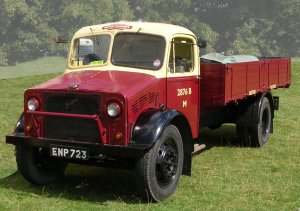
The railway system
was divided into six 'regions', the former GWR and SR lines were largely
unaffected and simply became Western Region and Southern Region. The LMS and
LNER lines in Scotland became Scottish Region, the remainder of the LMS
becoming London Midland Region. The former LNER lines in England were
subdivided into Eastern Region and North Eastern Region.
Scottish
Region covered the whole of Scotland including the northern ends of the West
Coast Main Line and East Coast Main Line as well as the rail network serving
the industrial heartland of the Central Lowlands between Glasgow and Edinburgh.
Going North they operated the line from Edinburgh via Perth and Inverness to
Wick and Thurso and from Edinburgh, via the famous bridges over the Firths of
Forth and Tay, to Dundee, Aberdeen and Inverness. From Glasgow the West
Highland line ran north to Mallaig and Stranraer served the area as a ferry
port for Ireland.
London Midland Region had two main lines from London.
The main line, which became the West Coast Main Line went via Rugby, Crew (for
the North Wales branch), Preston and Carlisle to Scotland. The second line ran
from St Pancras station in London via Derby, Leeds and then via the Aire Gap in
the Pennines to Sheffield and Carslile. In the later 1960's the LMR took
responsibility for the northern section (north of Aylesbury) of the old GWR
line from London to Chester via Banbury, Birmingham, Wolverhampton and
Shrewsbury. The LMR thus served industrial areas in the Midlands, south
Lancashire, Liverpool Manchester and Glasgow as well as the York, Derby and
Nottingham coal fields. Tourists used the LMR to reach the Lake District and
North Wales and the ferry ports of Holyhead, Liverpool and Heysham brought
traffic from Ireland.
North Eastern Region covered everything east of
the Pennines from the Humber to the Scottish border including the northern
section of the east coast main line (discussed below). With both Hull and the
Tyne ports and the industrial areas of Yorkshire, Durham and Northumberland
this region handled a considerable quantity of heavy freight. The North Eastern
Region was merged with Eastern Region in 1967.
Eastern Region covered
all of East Anglia and eastern England as far north as Doncaster and the Humber
estuary, it operated the East Coast Main Line (discussed below) as far north as
Doncaster. This region also had lines extending from London to Ipswich and
Norwich, the agricultural areas of East Anglia and the important ferry port at
Harwich, which brought continental rolling stock into the UK. The East Coast
Main Line (ECML) runs from London via Peterborough, Doncaster, York and
Newcastle to Berwick where the line continued under Scottish Region to
Edinburgh.
Southern Region has a number of lines radiating out from
Waterloo, Charring Cross and Victoria in London serving Southampton, Brighton,
Folkstone and Dover and (with running powers over the Western Region line) to
Plymouth. This region is noted for the intense commuter traffic in and out of
London but from a freight point of view it had only the industry along the
Thames (notably the oil refinery at the Isle of Grain), a limited amount of
paper and cement and the ferry traffic. There was a small coal field, near
Dover, which was exploited in the late 1950's and 1960's but that generated
little rail traffic.
Western Region operated from Paddington in London
with three main lines radiating outwards. One ran to the South West to Exeter,
Plymouth and Penzance, another ran west to Reading, Bristol and via the Severn
Tunnel to Cardiff, Swansea and Fishguard. The third line went out to Oxford
with branches in the Severn Valley serving Wales with its coal mining valleys.
Bristol, East Shropshire and South Wales were the industrial areas served,
Bristol, Cardiff and Swansea were all important ports and Fishguard had a ferry
service to Ireland.
The first CME of British Railways was Mr. R. A
Riddles C.B.E, however the move toward a national standard series of
locomotives, the devolution of power to the regions and the setting up of the
Ideal Stocks Committee to develop standard rolling stock designs, meant that
the CME's influence was less marked than in earlier years. Generally the
railways continued to operate as before and British Railways accepted delivery
of existing orders for rolling stock placed by the Big Four.
In 1952
the streamlined GWR rail-cars were tried in Lincolnshire and on the
line between Harrogate and Leeds (there had been some earlier trials of these
vehicles on the LNER during 1942). Also in 1952 the first British Railways standard enamelled signs appeared at railway
stations. Each region had its own background colour for these signs;
Midland Region - Maroon
Scottish Region - Light blue
North Eastern Region - Tangerine (Merged into Eastern Region in 1967)
Eastern Region - Light Green
Southern Region - Dark Green
Western Region - Brown (although they did try black as an experiment for Western Region signs).
The illustration below shows a large metal sign set up on the road outside the station and a double sausage 'totem' from a station platforms, both being from Midland Region.
Fig ___ Example of station signs (Midland Region)
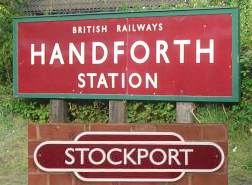
During this year there was a terrible storm
with hurricane force winds across Scotland which felled many thousands of trees
between Aberdeen and Inverness. Much of the timber was hauled by road to the
furniture and wooden goods factories in England but the railways managed to get
some of the work. The trees were mainly softwoods such as pine, which grow
straight and have few branches, making them an attractive load for bogie
bolster and bogie flat wagons. A lot of the timber was cut into shorter lengths
in Scotland and shipped in open wagons, these loads resembled pit props (for
which many were in fact sold).
In 1953 British Railways brought back
named freight trains with the reintroduction of the old LNER Green Arrow fully
vacuum brake fitted service for full wagon loads feeding the ports for exports.
The Transport Act of 1953 devolved a lot of power to the railway
regions, for example Western Region was allowed to try diesel hydraulic
locomotives when everyone else was opting for diesel electric's.
In
1954 the 1500v DC electrified 'Woodhead Tunnel' railway route from Manchester
to Sheffield was opened. The sketch shows the co-co passenger engine in the original lined green livery.
.
Fig___ 1500v DC Class 77 Co-Co Locomotive
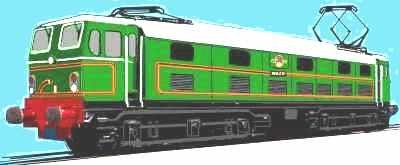
In 1955 'Pullman' coaches were reintroduced (they had
been withdrawn in 1929), the first lightweight four-car DMU's entered service
on Eastern Region and the government announced plans to allow the railways to
invest in infrastructure.
The original official colours for BR
passenger stock was crimson lower body with cream upper panels. The Western
Region had started painting some of its mainline coaches in essentially GWR
colours in 1953, other regions started using regional colours for main line
coaching stock after the general change in standard BR passenger livery to
maroon in 1955.
A 'Modernisation Plan' for the wholesale upgrading of
the entire railway system was rather hurriedly produced. This plan involved
extensive re-signalling based on colour light systems, a shift to diesel and
electric traction with plans for two thousand five hundred diesel locomotives,
over a thousand electric locomotives and fleets of diesel and electric multiple
units for local and rural passenger services. The plan called for upgrading of
goods facilities and building large numbers of new goods rolling stock, all to
be fitted with vacuum brakes.
Some 800 route miles (1,300 km) of main
line were to be electrified, along with 400 route miles of new suburban
electrification and an additional 250 route miles (400 km) of Southern Region
third-rail electrification. Electrification of suburban and outer suburban
lines had been pushed by the government since the early 1930's but other than
the London lines of the Southern Railway there had been little progress. A
couple of lines had been electrified in Lancashire and Cheshire in the 1920's
and the North East had a similar number of electrified lines dating from about
the same period, but there was no generally agreed standard.
The idea
behind the modernisation plan was to operate as before but with an overall
increase in speed on the system, the cost was estimated at £1,200,000,000
and it was expected to take fifteen years to implement. Most of the money
allocated to freight was to go on vacuum braked rolling stock and improved or
completely new marshalling yards of the automated 'hump' type. The new standard
goods rolling stock designs were still focused on the traditional British ten
foot wheel base four-wheeled chassis, although the small scale traffic was
already migrating to road transport. The success of containers in offering door
to door services was recognised and by this time about one percent of the
rolling stock was used for containers.
Coal accounted for well over
half the total freight moved and railways are well suited to this kind of high
volume traffic. Large numbers of steel bodied sixteen ton mineral wagons were
built for coal traffic, many of them however were simply re-bodied pre-war nine
foot chassis. Under the Modernisation Plan vacuum brakes were fitted to the
all-new steel coal wagons but these were found to be problematic as they were
vulnerable to damage by colliery wagon handling equipment. They were gradually
removed from mineral wagons as they went for repair and most of the later
batches of steel mineral wagons were built without the vacuum brake. The
unfitted mineral wagons remained in use into the later 1980's.
In 1956
the circular 'Rampant Lion' logo was introduced for locomotives (known by train
spotters as the 'ferret and dart board'), the D prefix appeared on diesel
numbers and British Railways settled on 25,000v AC as the standard for all
future electrification on the railways. In the same year the Liverpool Overhead
electric railway with its wooden bodied stock finally closed. On the passenger
side 'Third Class' was abolished in June 1956, although this simply meant
renaming existing accommodation as 'Second'. Second Class accommodation had
been very rare, most pre-war trains only catered for first and third.
In the mid 1950's the British Railways standard vacuum brake gear
appeared, an eight-shoe design (that is of the 'clasp' type) essentially
similar to my untutored eye as the later LNER pattern. Having said which wagons
with four-shoe vacuum brakes were still being built at least into the early
1960's. Also in the 1950's a more efficient buffer using a hydraulic system in
place of the coiled volute spring was developed. This was fitted to all new
rolling stock from the late 1950's on, early designs were quite long and
relatively thick in the shaft and housing, the later oleo-hydraulic buffers
have a shorter, fatter housing on the buffer beam.
One success on the
railways was the motor-rail concept, a passenger service which included
car-carrying bogie flat vehicles. This is not a new idea, the railways had
transported people in their own private carriages carried on flat wagons in the
1830's and the GWR had operated a car-carrying service through the Severn
tunnel in the 1930's, but such services were very restricted and required
advance booking. The new service was introduced between London & Perth
(operated by British Railways Eastern Region) in 1956. This service did away
with the advance booking and proved popular. This service and the subsequent
Motorail services are discussed in detail under Non Passenger Coaching Stock
Operations.
In 1959 British Railways banned four and six wheeled stock
from passenger trains. By this time there were not many vehicles involved,
freight stock affected included milk tank wagons, horse boxes, fish vans and
fitted cattle wagons whilst on the passenger side the ex LMS and ex LNER six
wheeled passenger brake vans were withdrawn and passenger coaches were no
longer attached to the early morning milk trains.
In 1960 the last
slip-coaches were dropped off at their stations and the massive Margam
marshalling yard opened in South Wales, occupying something like 170 acres and
containing over thirty miles of track it was the most modern in Europe. In
parliament however concerns were growing that the expenditure on the railways
was not bearing fruit and Earnest Marples, the transport minister (and major share holder in a road building consortium and an enthusiastic supporter of road trransport), initiated a
major reassessment of the future of the railway system.
At this time a
typical goods train carried 150 tons of goods, the tare weight of the wagons
was about the same and the steam locomotive pulling the train might be a fifty
ton tank engine or a hundred and fifty ton express locomotive. A really heavy
goods train could have an all-up weight of around 1,600 tons, as a comparison
the heaviest passenger train with its locomotive came to about 600 tons.
On the passenger side in 1961 the 'Blue Pullman' diesel multiple units
appeared on London Midland Region, offering relatively high speeds and
'Pullman' style services between London, Manchester and the Midlands. The
coaches were based on the rough riding standard British Railways Mk.2 coach (my
father tells me it was best to skip the soup course). These units were in
production up to 1966 and as the West Coast Main Line was electrified they were
transferred to Western Region where they remained in use into the mid 1970's.
Blue Pullman
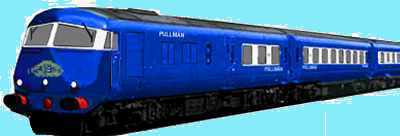
By this time the diesel multiple units and electric multiple units were
in service in some numbers, but there were still 16,000 steam locomotives, with
about 1,350 diesel and 75 electric locomotives. British Railways operated some
19,000 route miles (30,000 km) of track, as most of this was double and quite a
lot was quadrupled, the actual mileage of track laid was in the region of
50,000 miles (80,000 km), all of which had to be maintained.
Another
railway event in 1961 was the introduction for trials of the gas-turbine
powered GT3 locomotive. Resembling a streamlined steam locomotive in outline it
had geared mechanical transmission. Turbine powered, mechanically coupled
locomotives were popular in America for heavy freight but the GT3 proved to be
a one-off on British lines. By this time the railways were having real
difficulties competing with the roads for general merchandise of 'sundries'
traffic. There was a major rationalisation in 1961 which saw the sundries
traffic concentrated at five hundred and fifty stations with another four
hundred stations offering reduced facilities. There were still about four
thousand private sidings in use across the network from short single sidings
into a scrap metal merchants to lines linking into large internal railway
systems in the major industries and ports. By this time over 40% of the coal
moving on rail was in block train loads but there were still over 5,000
stations which received coal for their local coal merchants. In the cities the
coal traffic was often big enough to justify several entire train loads a day
but at smaller yards the merchant might require only a few wagons a couple of
times a week. Overall about 40% of the wagon load traffic in minerals and
general goods was moving in block train loads.
Following the 1962
Transport Act the railways came under the control of the new British Railways
Board (BRB), whose chairman was Richard Beeching. Mr. Beeching had made his
name in rationalising ICI and was appointed to the British Railways Board with
the specific task of quickly making the railways operate at a profit (apparently regardless of the longer term implications). The
expensive modernisation in the 1950's had not brought the railways into
profitability and the general public was increasingly concerned by the amount
of public money being used to support the railway system.
Within the
year the British Railways Board announced that twelve of the twenty nine
railway works inherited by British Railways were to close. On the positive side
the BRB set up the Railway Research Centre at Derby, which soon became the
worlds most advanced railway research establishment. This organisation's work
allowed 100 mph plus (161+ kph) passenger trains to run on standard tracks by
the late 1970's. Also in 1962 British Railways, prompted by Beeching,
introduced a major shift in policy on oil shipments and began offering reduced
rates to encourage the oil companies to ship oil as block loads.
In
1963 the 'Lava Lamp' appeared in the shops and on the railways the Red Star
service for high value registered parcels conveyed by passenger train was
introduced. Also in this year the first long term contracts for the bulk 'train
load' movement of oil were signed with seven companies. The seven oil firms
involved were Petrofina, Mobil Oil, Gulf Oil, Esso, Regent Oil, Shell Mex and
BP (Shell & BP ran a joint rail tanker operation at this time). Thereafter
most oil travelled as 'block loads', that is an entire train of oil tank wagons
all loaded at the same place and going to the same destination. This meant the
end of a lot of old tank wagons and fleets of more modern long wheel base tanks
similar to the Peco 45 ton tank wagon were built. The block trains of oil
tankers still had to follow the old rules however so in pictures dating from
the 1960's you will see a single empty 16 ton mineral wagon used as a 'barrier
wagon' between the locomotive and the oil tanks. By this time the railway goods
fleet had been reduced to about eight hundred and fifty thousand wagons and
vans, most were of fairly modern designs and fitted with vacuum brakes for
'express' goods trains.
The railways were set up under Acts of
parliament which laid down their responsibility to provide passenger services and
thanks to the common carriers legislation the railways were obliged to carry
any goods offered, even if this meant operating the train at a loss. Prior to
the second world war the railway companies had managed to turn in a small but
consistent profit, competition from road services was starting to gain ground
in the immediate pre-war period leading to the 'fair deal' campaign already
mentioned. The war changed everything and the railways were expected to 'do
their bit' for the war effort and managed to deal with all the additional
traffic under very difficult conditions. All of this had generated a culture of
service in the railways, the management had a great deal of professionalism and
dedication but little commercial understanding.
It was in 1963 that the
Railways finally came under the aegis of the Factory Acts for the first time,
giving railway company employees improved working conditions. Later that year
the British Railways Board published the Reshaping Report. This report was
largely authored by Dr. Beeching himself. It is probable that most people see
Dr Beeching as 'the man who destroyed the railways' but that is really a
somewhat unfair assessment, he eventually parted company with the following
Labour government when the Prime Minister (Harold Wilson) decided he was much
too 'pro-rail'.
Dr. Beeching's findings were grim, over half the system
was not paying for its own upkeep, a third of the system was employed carrying
only one percent of the goods, of the seven thousand stations about half only
contributed two percent of the revenue and twenty five percent of receipts were
generated by only thirty four major stations. It should be noted that these
findings have been disputed on various grounds. For one thing the figures used
were based on a single week and are statistically suspect. There were
accusations that the researchers were instructed to paint a bad picture, for
example for their figures on the Somerset & Dorset line they chose an
annual holiday period noted for particularly low traffic. This seems unlikely
to have been a policy decision however it now appears that there was some pressure from 'above' to find reasons for closing down lines.
There is little doubt the
railway freight system was inefficient, the average wagon only carried a load
for about 45 miles (72 km) a week. The reshaping report heralded the closure of
over eight thousand route-miles (12,900 km) of track serving about 2,000 local
stations. This was however a continuation and acceleration of an existing
trend, some four thousand miles of track had gone under the Big Four between
1923 and 1948, another three thousand had been closed by British Railways
between the end of the war and 1959.
Under the Beeching regime large
freight depots and local goods yards were closed on a massive scale, from over
five thousand to less than a thousand. With the reduction in single wagon load
movements about four hundred marshalling yards were closed, leaving about two
hundred in operation. The less-than-wagon-load 'sundries' depots were cut back
to less than a hundred in the whole country, before this time most towns had
several sundries depots, originally built by the competing pre-grouping
railways in the late 19th and early 20th century. These changes released more
of the new diesel locomotives and hastened the end of the increasingly
expensive steam engines.
Fig___ The post Beeching railway system
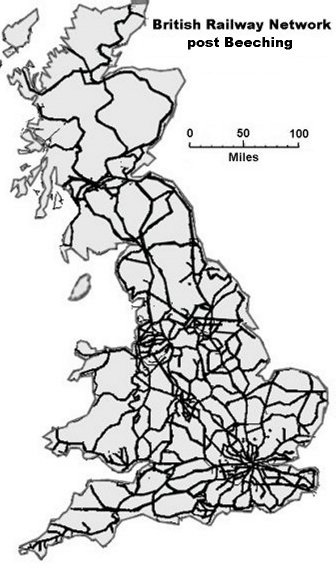
The 'unwanted' lines were lifted, the rails sold for scrap and the land sold to developers. In retrospect what happened was that a large proportion of the investment in infrastructure made by the preceding five generations was essentially flogged off on the cheap, a decision that within thirty years would be deeply regretted, partly because of the growing need for passenger services to by-pass over crowded roads and partly for the knock-on effects this had on British industry.
In the Beeching vision of the future the railways would concentrate on
block train services, phasing out less-than-wagon load traffic and reducing the
number of single wagon loads traversing the system. Coal was still the largest
single traffic on the railways and the new plan involved the exclusive use of
hopper wagons for bulk minerals. Larger users such as power stations and the
like were to be supplied by so-called merry-go-round (MGR) trains and delivery
of single wagon loads of coal to local traders was to end.
The
merry-go-round system for coal deliveries was introduced in 1964. The special
MGR wagons are fitted with automatic discharging apparatus and at the loading
and discharging points they slow down to about 4 mph (6.5 kph), about human
walking speed, as they pass under the loading hoppers or over the discharging
bays. The Central Electricity Generating Board paid for specialised reception
facilities at the power stations but the National Coal Board refused to pay for
the modernisation of the loading gear at the mines. This resulted in a curious
operating pattern at some coal mines, the loaded wagons would be collected by a
British Railways locomotive and taken as an MGR train to the power station and
back again to the pit, where the wagons would be moved about the mine's rail
system in small rakes of perhaps four or six wagons by elderly steam tank
locomotives.
Merry-go-round was not a new idea, Beeching had come from
ICI where a merry-go-round service of purpose built PO bogie hoppers had been
operating since 1935. These purpose built 23 ton capacity hoppers operated as
'block trains' carrying limestone from Tunstead in the Peak District to
Northwich in Cheshire. The hoppers replaced large numbers of traditional wooden
bodied open wagons, mainly Midland Railway designed three plank types. After
loading the hoppers were left for a couple of hours on a siding before
beginning the return journey, during which time they were checked and
maintenance was done as required. The hoppers were built by Charles Roberts,
vacuum brake fitted throughout their life, they were coded PHV under the TOPS
system after 1974 and they had numbers prefixed ICI. Rumours of their demise
were circulating for some time, their bogies were reportedly approaching the
end of their working life in the late 1980's, but it was early 1998 before they
were finally replaced by rakes of four wheeled PGA 50 ton hoppers hired from
CAIB. These proved unsuitable as the dust blew off them in transit and they
caused severe vibration and property damage to adjacent buildings due to the
increased axle loading. They were replaced by large bogie hoppers after a few
years and the track on the route was substantially overhauled.
Motive
power for the ICI hopper trains was always sturdy, the LMS 8F freight
locomotive was a regular on the run, augmented by British Railways standard
heavy steam locos. When diesels took over various Class 4x heavy locomotive
types were used, notably Class 47's and (in the 1980's) pairs of Class 20 locos
coupled nose-to-nose. In their later years the old ICI wagons were hauled by
pairs of vacuum brake fitted class 37 locomotives, the CAIB wagons were hauled
by a single Class 56 or pairs of Class 37's and the new bogie wagons are hauled
by EWS Class 60 heavy freight engines. The rake would be dropped off and if the wagons could not
be left over the discharge bay they would be shunted through the discharge bays
later by a small works locomotive. There were already a number of hopper wagons
in service but the 21 ton type with its twelve foot wheel base chassis became
the nominal standard for this work.
All house coal was to be shipped in
hopper wagons to special 'concentration depots' from where the traders would
have to arrange road delivery to their own premises or customers. This was not
popular with the traders who switched to road delivery directly from the
collieries and by the early 1980's many of the house coal concentration depots
were closed down while others were used for receiving road stone for road
building work (one example is at Portwood, south of Manchester).
In
1964, following a series of derailments, British Railways decided to impose a
45 mph (72 kph) speed limit on all four wheeled goods stock, although with so
much unfitted stock in service the effect of this would have been small. By
this time the railways were moving over two hundred block oil trains a week and
seven more oil companies had signed up for long term contracts. Also in 1964
the Cartic Four car-carrier, jointly developed by British Railways and Ford,
was introduced. This was an articulated set of four double-deck car transporter
bodies carried on five four-wheeled bogies (a model is available as an etched
brass kit from Taylor Plastic Models). Ford's initially chartered in sixty
separate services each week, each comprising five or more units.
It was
in 1964 that the new 'Corporate Image' was established and the double arrow
logo was introduced. The Class 83 loco shown below has the new livery but retains the original cast metal cabside numbers.
Fig___ Class 83 showing 1964 BR 'corporate blue' livery but with cast E number
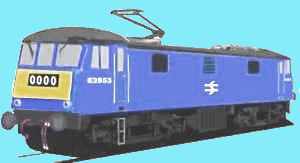
The name British Rail was adopted for marketing purposes
(the company was legally still called British Railways) and staff were issued
with 'modern' grey uniforms designed by one of the top designers. The uniform
was based on 'efficient' German styles and was intended to inspire confidence
in the public.
One experiment ended in 1964 with the abandonment of the
original road-railer concept after extensive trials. These vehicles consisted
of an articulated semi-trailer with two road wheels and two railway wheels on a
rocking arm arrangement at the rear. On the roads they were pulled by
conventional articulated lorry tractors and on rail the front end of the
trailer was supported on a special four-wheeled wagon. The system was trialed
using a rake of the vehicles and there were few teething problems. The
road-rail vans were simple to operate, requiring no special facilities at the
terminals, but the payload was only six tons and it was felt that getting the
trailers on and off the railway took too long. The prevailing opinion was that
the Freightliner service would handle the traffic for which the road-railer was
designed. One objection was that the road-rail wagons could not be marshalled
with other conventional railway stock but that seems a doubtful point in view
of the plans for Freightliner.
The success of early container services
such as the Condor and later Speedfreight operations on the London Midland
Region had been noted in the Beeching report. By this time the modern stackable
container was already starting to dominate the American trades and looked
likely to become a successful international standard. The initial standard size
and handling arrangements had been established by the American Standards
Association in 1961/62 and was adopted by the International Standards
Organisation (ISO) in 1965. As an initial response British Railways had
converted about a hundred 'lowmac' four wheeled well-wagons to carry the twenty
foot containers (see Fig___). In addition five dual-braked ferry-equipped plate
wagons (similar to the type offered by Peco) had their vacuum brakes and
bodywork removed and mountings for ISO containers fitted. These wagons operated
in normal goods trains with the containers being handled by cranes or
specialist machinery at the ports or factories.
Dr. Beeching believed
there was the potential for a successful trunk-haul railway ISO container
service with road collection and delivery at either end. The ISO containers
were to be moved as block loads by a new 'Liner Train' inter-city service (this
became Freightliner by the time the plan was implemented). Beeching had to
fight hard for the necessary investment in specialised terminals and he
insisted that the new container wagons were built to carry the new standard
eight foot by eight foot containers. As the containers were too large for
shipping on normal British Railways vehicles the Freightliner wagons had a very
low floor level and their bogies used smaller than normal wheels. These new
bogie 'Conflat E' vehicles were ordered in 1964 and the fleet eventually
totalled some 2000 wagons. Liner Train services began in 1965 by which time the
name Freightliner had been adopted. Freightliner services fall outside the main
stream of goods traffic and they are considered in detail in a separate section
under Operations.
At about this time the British Railways Board began
trying to rationalise the plethora of diesel locomotive types, most of those
which had been built in small numbers were withdrawn by the end of the 1960's
with a few surviving into the first years of the 1970's.
In 1966 the
Blue Pullman diesel multiple units were transferred to Western Region as the
West Coast electrification progressed Northwards and London-Manchester electric
hauled services began. Also in 1966 the railways own parcels business was
separated from the general merchandise traffic and the general merchandise side
became a new Sundries Division.
In 1967 the National Freight Train Plan
was produced by Dr. Beeching's team. There has been much debate about the value
of this plan and even more about the implementation. A lot of the 'service'
elements offered by the railways to their customers were phased out, coal yards
would no longer be regularly 'shunted' to clear out empty wagons and transits
formerly arranged to suit the customers needs were re scheduled to suit the
railway's head office policy. This shift in policy away from customer service
is generally credited amongst railway freight people as being responsible for
the loss of a lot of the valuable freight traffic on the system.
The
first 100 ton 60 mph (97 kph) bogie oil tank wagons, as available from Graham
Farish, appeared in 1967. First used by Shell Oil these tank wagons impressed
the oil companies and their introduction secured the oil traffic for the
railways and averted a plan to build overland pipelines. The new bogie tanks
and the earlier four-wheelers will probably be replaced in the early twenty
first century as they become life expired. Their replacements may be large
bogie vehicles which are favoured under the current charging system or
four-wheeled fifty-ton wagons which are cheaper to build and maintain.
Elsewhere on the railways in 1967 the former North Eastern Region and
Eastern Region were merged into a single Eastern Region and the very last
shunting horse, Charlie, was retired from the Newmarket goods yard.
In 1968 the cross-channel hovercraft service was established, using the giant SRN 4 hovercraft operated by a subsidiary of Britsh Railways called Seaspeed.
Fig___ SRN4 in BR Seaspeed Livery
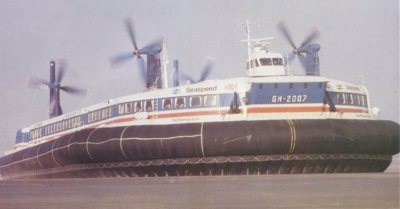
The SR.N4
(Mountbatten class) weighed in at about 200 tons, its propellers are 21 feet
across, making them the largest driven propellers in the world, it carried 254
passengers and 30 cars across the channel. Top speed was about 80 knots and the
journey took only about 30 minutes.
Barbara Castle's Transport Act of 1968 set up the National Bus Company
and introduced local Passenger Transport Authorities and Passenger Transport
Executives to co-ordinate urban and suburban services. This Act also
established the National Freight Corporation to act as a co-ordinating body for
all freight movement and transferred Freightliners Ltd. from British Railways
to the National Freight Corporation. The railways less-than-wagon load
'sundries' business was deemed a failure and on January 1st 1969 the railway
Sundries Division became National Freight Carriers (another division of the
National Freight Corporation). National Freight Carriers took over the
ownership of the railway owned road transport. At the time the railways were
operating nearly ten thousand motor vehicles and twenty three thousand trailers
but following the transfer of ownership they were progressively re-liveried
with National Carriers on the side.
Fig___ Ex BR road vehicles in NCL livery
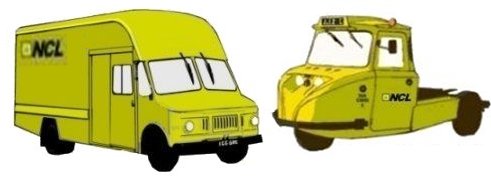
The photo below is from a 1970s BR publicity leaflet, it shows a large parcels depot at a major passenger station, the van in the background has the NCL logo.
Fig___ Parcels traffic at a major station
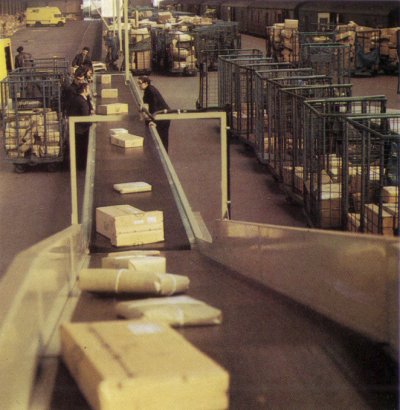
Road vehicles such as the vans required for
parcels services or lorries for the remaining full wagon load business (notably
for the older railway containers operating door-to-door services) were leased
back to British Railways. Within a couple of years British Railways liveried
road vehicles, once commonplace, were becoming comparatively rare as vehicled were repainted in NCL colours.
The plan was
for National Carriers to pass suitable cargo to the railways but there seems to
be little evidence that this was done and many of the railway sundries depots
were converted for lorry traffic. The old drop-side three plank wagons were no
longer required for freight and any which had not already been converted to
steel coil wagons and the like were transferred en-masse to the engineers where
they could be used for ballast and spoil (the mixed dirt and ballast dug out
from the track).
Ken Ward, a regular in the uk.railways newsgroup advised that in 1969 British Road Services, the nationalised road haulage company, introduced regional colours on its general goods vehicles as follows: South Eastern Division - ROYAL BLUE, Scottish Division - TRAFFIC BLUE, North Western Division - SEA GREEN, North Eastern Division - ROAD HAULAGE RED, Midland Division - NUT BROWN, South Western Division - ROAD HAULAGE GREEN, Western Division - LEAD GREY, Eastern Division - TURQUOISE BLUE. Parcels vans operated by BRS remained green.
By this time the idea of the 'basic railway' was being
tried out as a way of avoiding branch line closures. Stations on these lines
became unstaffed and the guards sold the tickets on the train.
In 1970
the Merehead Terminal for Foster Yeoman crushed stone opened, at the time
British Railways was still moving stone in old unfitted 'iron ore' tippler
wagons and the terminal was soon sending out eight trains a day.
The
British Railways Research Centre at Derby had been investigating the use of
roller bearings for freight stock, first used in the early 1920's on heavy
American passenger coaches. The Americans conducted large scale comparative
trails of bearings on their heavy freight stock and the roller bearing then
became standard on all US rolling stock. Roller bearings had appeared in the UK
in the late 1920's, although they were only used on passenger stock. The new
Cov AB air-braked vans, introduced in 1969, were fitted with roller bearings
and swinging link suspension to allow high speed running. The Cov AB had a
payload of 29.5 tons but when running at 75 mph (121 kph) the maximum load
allowed was only twenty tons. The vans had a gross loaded weight of either
forty one or forty six tons for payloads ranging from twenty eight and a half
to thirty one tons, the variations being due to the different types of doors
used. The open wagons (OAA) introduced in 1971 also featured roller bearings
and offered payloads of thirty two tons with speeds to match the covered vans
(see Fig___).
From the 1970's roller bearings were fitted to all new
British Rail stock and retrofitted to some older vehicles, a good example being
the old LNER fish vans of the type offered by Peco, which had suffered from
overheating axle boxes as train speeds increased. Roller bearings allow higher
speeds and these fish vans continued in service, many being converted to as
parcels vehicles, into the 1980's (see Fig___).
In 1971 the last steam
engines (used for stores trains and the like) were withdrawn on the London
Underground system and the last postal drop by a Travelling Post Office (TPO)
coach took place near Penrith (see Freight Operations - Non Passenger Coaching Stock - Parcels and Mail for details on this service).
By 1972 over two thirds of all the railway freight traffic was being
moved in block trains. Most coal was shiftred in the HAA hoppers whilst smaller users and outlying domestic coal depots were supplied by the BR 21 ton hoppers and from the mid 1970s by the air-braked HBAs.
By this time the dangers of 'blue' asbestos, widely used
on as an insulating material in the 1950's, and 1960's, had come to light and
the use of the material was banned. This in turn resulted in the condemning of
many older British Railways standard coaches. The workmen dismantling these
older vehicles had to be protected from the asbestos dust as they removed it
and complicated procedures for dismantling coaches and locomotives were
required for this work.
In 1973 There was some good news for the
railways, Esso renewed their contract with British Rail for another ten years
and British Aluminium signed a contract to send ingots by rail from the
smelters to rolling mills. British Aluminium also contracted British Railways
to carry powdered alumina from Invergordon to the smelters. This latter service
used elderly purpose built stock and when they became life expired old BRT
(British Railway Traffic & Electric Co Ltd) grain wagons as available from
Peco were drafted in.
In the mid 1970s there was a refurbishment programme conducted on the now elderly first generation diesel multiple units. From about 1974 at least some of the refurbished units were re-liveried in white with a rail-blue stripe along the sides and full yellow ends. The photo below is taken from BR publicity material produced in about 1980/
Refurbished and reliveried DMU in about 1980
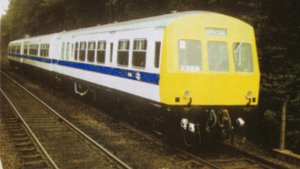
In 1974 British Rail introduced 'TOPS' (Total
Operations Processing System), a computerised stock routing and control system.
TOPS is more fully discussed in the section on Control, briefly under TOPS
every type of wagon and van was given a three letter code which, coupled with
individual wagon numbers, allows the operations department to allocate and
track individual vehicles through the system. The London Paddock Wood rail
freight terminal opened in 1974, largely funded by the Spanish firm Transfesa
the terminal was also open to traffic from other continental sources
The Railways Act 1974 wrote off British Railways accumulated debts and
included an official requirement that future passenger services would be
comparable with those operating at the time. This Act included a provision for
government aid in the form of a 'Freight Facilities Grant' of up to 60% of the
capital cost of a change to rail haulage of freight. These grants were to pay
for laying sidings, access roads, cranes and setting up buildings on private
land but the applicants had to make a case showing that environmental benefit
would accrue from a rail service. This provision was in Section 8 of the Act
and in 1978 these 'Section 8 grants' were subsequently extended to help with
the cost of building privately owned rolling stock. In practice this provision
proved somewhat illusory, take up was restricted by political difficulties,
applications took a year or more to process and in twenty years only about half
the cash theoretically available was ever handed over.
In 1975 the TOPS
system was finally fully implemented throughout Britain and the new National
Railway Museum opened its doors at York. The entire collection from the former
Clapham museum had been moved to York over the preceding months, some by rail.
Brake vans became an increasingly rare sight as the older rolling stock
was phased out, firstly a lot of the unfitted vehicles were scrapped, then a
start was made on the vacuum fitted wagons and vans. Southern Region was the
first to have only fully fitted rolling stock in general service in the late
1970's, although a few unfitted wagons and specialised units soldiered on in
specific trades (mainly in the North) and in departmental service.
In
1976 the new High Speed Trains (HST's or HS125's) appeared on Western Region.
High Speed Train (original livery)
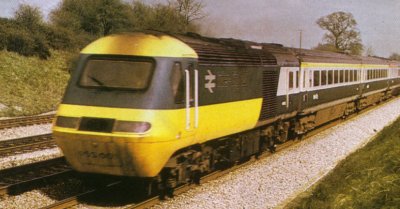
The HST's replaced the twenty year old 'Blue Pullman' sets and were originally
designed as fixed rakes and designated as 'Class 253 diesel multiple units'.
They were later reclassified as Class 43 locomotives and standard Mk.3 coaches.
Also in 1976 the Class 56 heavy freight loco was introduced, these lasted in service into the 1990s and a few were sent to work in France on freight duties, but they proved difficult to maintain. The sketch below shows the original liuvery, for the Load Haul livery see Appendix Four - Diesel Locomotive Types.
Class 56 heavy freight loco (original livery)
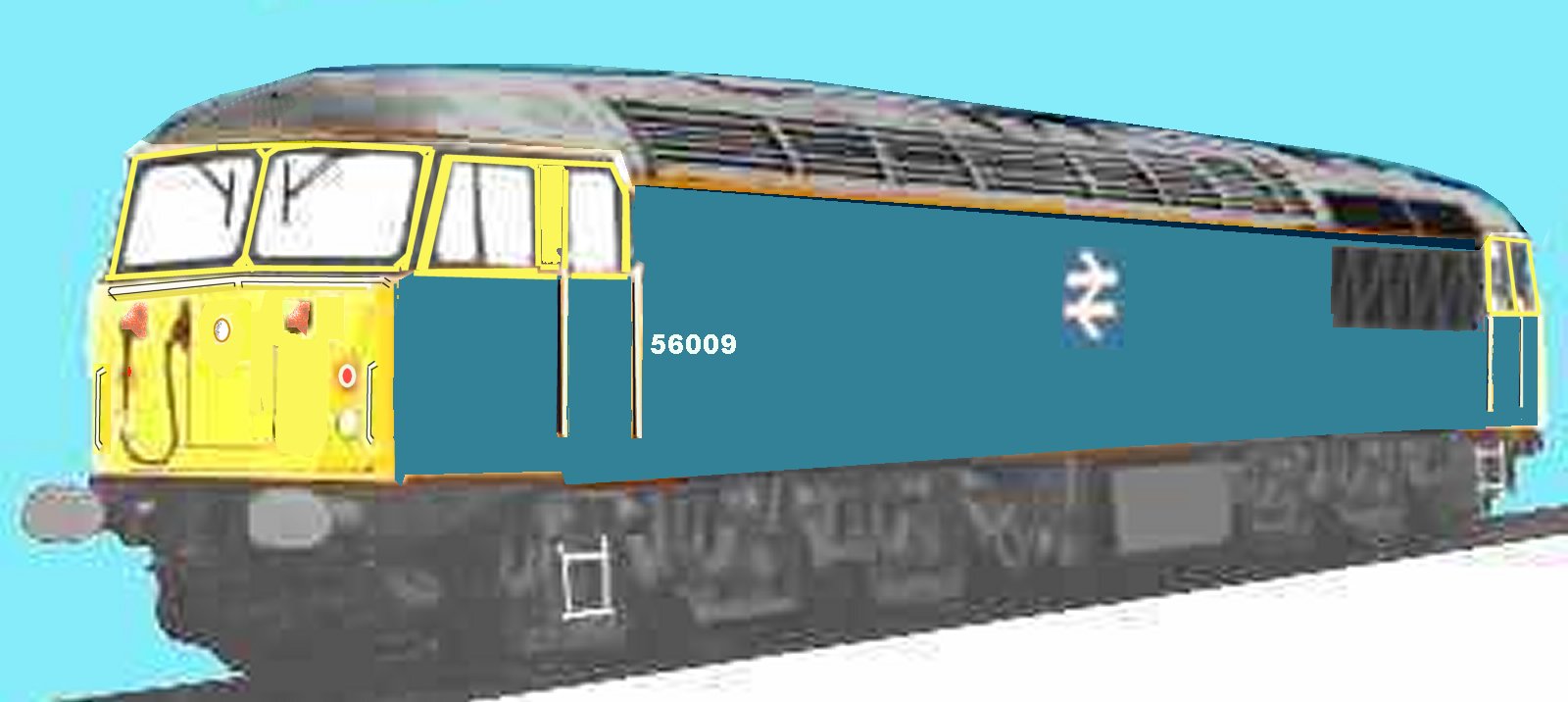
In the later 1960's with the success of the ISO container the decision
had been made to phase out the old style wooden containers and the more modern
'Speedfreight' containers with their Conflat A and long wheel base Condor
Conflat P wagons. Most of the wooden containers built to the pre-world war two
designs were condemned in the early 1970's but a few of the Speedfreight
containers lasted in use until about 1977 (Speedfreight containers are
discussed in the section on Unit Loads on the Railways).
In the later 1970s the first 'binliner' trains began operating, shipping containeries compressed waste to land fill sites, and within a few years London Manchester and Bristol were all using this approach. The photo below, from a BR publicity leaflet, shows one of the prototype containers used for this work.
Prototype Easidispose container
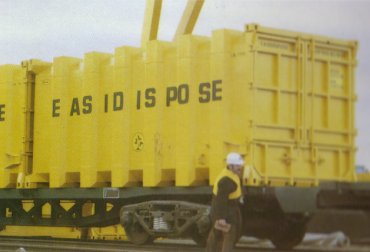
In 1977 the
government decreed that there would be no further subsidies paid to the
railways to support goods traffic and the railway goods business has had to pay
its own way ever since. The roads meanwhile were being subsidised to the tune
of several hundred million pounds a year. As Dr. Beeching had pointed out the
road lorry does several thousand times as much damage to the roads as the
private car but the government failed to see the logic of this argument.
In 1978 Foster Yeoman signed a long term contract with British Rail to
haul more crushed stone, London Brick Company signed up to ship palletised
bricks carried in open topped half-height containers from Stewartsby to London,
Liverpool and Manchester and Freightliners Ltd became a wholly owned subsidiary
of British Rail.
In 1980 the steel works at Consett closed which had a
significant effect on rail revenue in the Midlands. In the same year the brown
form of asbestos was banned from use and had to be removed from public places
where it had been used as an insulating material. White asbestos remained
officially safe for a further twenty years before doubts were raised about the
hazards to health it posed.
In 1981 the railways began advertising
their new all air-braked freight services. There were sixty Air Braked Network
(ABN) services a day offering overnight transit between terminals. This
overnight service was promoted as something rather new but in fact it was a
return to practices which had been commonplace in the later 1930's. There were
only just over three hundred goods yards in operation, by this time they were
called 'freight terminals'.
In 1982 the Venice Simpleon Orient Express
Pullman stock entered service on Southern Region. Also in 1982 agreement was
reached with the railway unions allowing 'driver only operation' on some
freight services, doing away with the 'second man' in the engine. The
unions objected on the grounds that a second pair of eyes was a safety issue.
They may have had a point as the incidence of 'signals passed at
danger' increased thereafter and the money has never been available to add
automatic warning systems (although these are standard on the continent). In
the same years there was a change in the way the accounts were drawn up for the
railways. The entire business was divided up into five 'sectors', each of which
was to be operated as a separate 'company'. These 'sectors' were: Intercity for
long haul passenger services, Network South East for commuter services in that
area, Provincial (later renamed Regional) for commuters elsewhere in the UK,
Parcels and Railfreight. Freightliners were already operating as a separate
entity.
The Railfreight business was further subdivided into Coal,
Construction, Petroleum, Metals and Distribution. The Coal, Construction,
Petroleum and Metals sectors dealt with complete trains running as block loads,
Railfreight Distribution dealt with single wagon load traffic including ferry
wagons. Later in 1982 Scotrail was established as a separate entity dealing
with all traffic in Scotland. They adopted the 'Scotty' dog as a logo and this
was painted on the sides of their locomotives.
Fig___ Class 26 Locomotive in 'Railfreight triple-grey' with coal sector marking and Scottie Dog logo
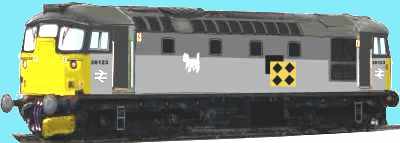
In 1983 Railfreight
Distribution formalised the new all air-braked wagon load service network,
using the name Speedlink Distribution. Low value cargo such as scrap metal and
domestic coal were not initially included in Speedlink services although air
braked coal hoppers coded HBA were built for the latter trades. British Rail
stopped carrying road stone in its own wagons in the mid 1980's and all this
traffic is now carried in private owner stock, mostly leased from the wagon
hiring firms, generally fifty-ton four wheeled hopper wagons and hundred-ton
bogie tippler stock.
During the early 1980's more classes of diesel
locomotive were withdrawn and all remaining locomotives were fitted with air
brake systems. Vacuum brakes were retained on some locomotives as there
remained a lot of vacuum braked wagons in service. Passenger trains became
increasingly comprised of multiple unit stock and locomotives were transferred
to freight working. Not all locomotives were ideal for freight, for example the
class 47's had been designed as mixed traffic types and were geared for high
speed running in passenger services.
By 1983 there were about sixteen
million private motor cars on the roads, an eight fold increase since the
railways were nationalised. By this time there were about a hundred and fifteen
general freight terminals operated by British Railways and another hundred and
twelve terminals operated by private contractors. There were also a number of
private sidings, handling only the owning firms goods, but the numbers of these
tended to vary.
In 1984 the government decided that BR should sell off
any profitable parts of the business that did not involve running trains. The
railway owned hotels were all sold (apart from one in London), the Sealink rail
ferry's and other non-train ferry services inherited from the Big Four and
operated by BR, the cross channel hovercraft services etc. I am not sure where
all the money went but I reserve the right to be cynical (it was at about this
time the MP's decided they needed to tart up their canteen, they spent 5
million on it but it ended up looking remarkably like an oriental brothel.
There had recently been a scandal involving a woman called Pamela Bordes and
the canteen was soon christened 'the Pamela suite', the MPs felt this was
inappropriate so they spent another two million having it de-tarted). On the
rails in 1984 the class 150 'sprinter' passenger sets appeared and a new form
of signalling for single track lines called Radio Electronic Token Block
Signalling (RETB) was introduced in Scotland. RETB is more fully discussed in
the section on signalling. Also in Scotland mixed trains were reintroduced with
specially modified container flats being attached to passenger services
operating between Aberdeen and Wick.
In the same year the last steam
heated coaches were withdrawn and vacuum braked stock was no longer used in
Speedlink trains, although vacuum fitted stock such as metals flats and the ICI
hoppers operating as block trains continued in service. This meant the end of
Speedlink trains having a mix of air and vacuum braked vehicles and hence an
end to the use of traffic brake vans which had been required on these mixed
trains. There were still a lot of unfitted wagons in service, over a thousand
unfitted twenty one ton end door wagons coal wagons (TOPS coded MDO) were used
to feed the coal hoists, tipping into ships at South Wales coal ports.
There were a number of mineral hopper wagons (TOPS coded HUO and HTO)
still in service in Wales and the North East, British Alcan was still running a
small fleet of unfitted alumina hoppers coded PAO and SCO whilst old SJO strip
coil wagons were still in service doing short hauls in Wales.
By the
end of 1984 there were a hundred and fifty separate all air-braked Speedlink
services in operation but all was not well. A lot of uneconomic traffic had
been transferred from the old vacuum braked wagon load network to Speedlink and
the train ferry traffic proved a drain on resources. The ferry traffic system
had been established many years before and the agreements reached with other
countries meant that all the British share of any revenue went on servicing the
ships, the goods were hauled for free inside the UK. This worked when the
railways owned the ferry ships but not when these had been sold.
In
1985 the rail unions agreed to single man operation of some freight trains, the
first time trains had not had a guard on board for over one hundred and fifty
years. During the year a lot of new passenger liveries appeared as the local
PTE organisations had diesel and electric multiple units painted in their
livery and thanks to the GWR's 150th anniversary celebrations several
locomotives were turned out in GWR green livery. Also in 1985 British Telecom
was privatised.
In 1986 British Gas was privatised whilst on the
railways Network South East applied it's own distinctive livery for
passenger stock.
Class 307 multiple unit in NSE livery
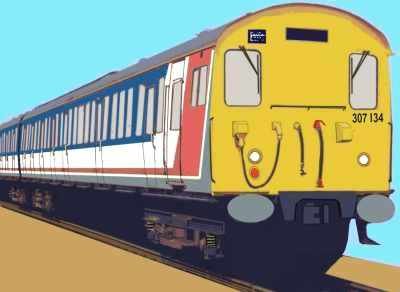
By this time Speedlink was considered a failure and
British Rail was looking at ways to close the system down. This did not go down
terribly well with the private sector which had invested several hundred
million pounds of its own money in terminals and rolling stock and there was
some serious arguing in progress behind several sets of closed doors.
In 1987 the last of the old 'coal hoists', used to tip coal into ships
in the South Wales ports ceased operating and British Rail sold the most of the
remaining twenty one ton, hand brake only, MDO coal wagons to the National Coal
Board for internal use within collieries. Some of the vacuum fitted twenty one
tonners (MDV) had a pipe added to run with air braked stock and were re-coded
MDW and these wagons were then used for coal and scrap metal traffic in
Scotland for several years.
On the positive side fish returned to rail
with regular trains scheduled from Grimsby up to Scotland and the automated
Docklands Light Railway opened for business. Also in 1987 British Rail renamed
'second class' on passenger trains as 'standard class' and Railfreight was
established as a separate entity, with its own management and fleet of
locomotives. However with political pressure to keep the punters happy freight
trains could still loose their crew or even their locomotive if a passenger
train got into difficulties. It was in 1987 that the national airline British
Airways was privatised, at the same time the British government pulled out of
both the multinational Airbus aircraft building consortium and the Arianne
space launch program.
In 1988 the 'banking' of trains on the Lickey
incline was abandoned (later reintroduced by EWS for heavy freight trains using a Class 66 engine), the last newspaper trains were run and the last of the
wooden bodied, vacuum braked, China clay 'hood' wagons were withdrawn and
replaced by a British Rail built and owned fleet of 124 air braked hoppers
coded CDA. These were basically the standard 'merry-go-round' HAA coal hopper
wagon fitted with a power operated roof and were the last major goods stock
order from British Rail.
Also in 1988 a new region 'Anglia' was
established and Freightliners Ltd. was merged with Speedlink. It was in 1988
that the British HOTOL space-plane project was abandoned due to lack of
government support. Invented by British engineer Alan Bond in 1983 and jointly
developed by Rolls Royce (engines) and British Aerospace (airframe) the HOTOL
had a revolutionary engine which functioned as a jet until the air became too
thin then switched to rocket mode for the final boost into space. It was in late 1988 that the number of people employed in manufacturing
dropped below five million for the first time since the nineteenth century.
In
1989 the water boards were privatised, becoming independent water companies,
and British Rail Engineering Limited (BREL) was sold into private ownership. In
the same year Redland Stone
introduced a new self-discharging train made up of hopper wagons equipped with
diesel powered conveyor belts feeding a bogie wagon with a swinging discharge
arm. On the passenger side the Class 91 electric locomotives entered service and the first Mk.4 passenger coaches appeared in service.
Fig___ Class 91 Locomotive
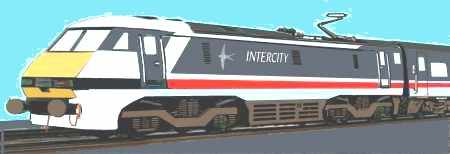
In 1979 there had been about 150,000 individual freight wagons in use
on the British railway system, by 1989 the total was down to about 40,000,
roughly half of which were privately owned. Having said which, thanks to the
increasing capacity of wagons and more efficient control, the actual tonnage of
freight carried had not reduced greatly over the decade. Of the British Rail
owned stock about half was accounted for in MGR coal hoppers, much of the
remainder being specialised stock for the transport of metals with only a small
number of general merchandise wagons and vans. There were increasing numbers of
private owner or leased vehicles. By the end of the 1980's about half of
British Rail's revenue was from coal and coke merry-go-round operations, the
remainder from aggregates, cement, steel, oil, grain, chemicals, bricks and
motor vehicles.
Non-bulk operations were covered by the Speedlink
service carrying individual wagon loads, mainly palletised, with inter-city
block container freight carried by Freightliners. Parcels and some remaining
perishables were carried in vans, usually of the non-passenger coaching stock
variety. Very few unfitted wagons remained in service, a small fleet of British
Rail owned unfitted four wheeled tippler wagons were carrying a black sand from
Immingham docks to the Tri-Oxide plant at Grimsby and the engineers probably
still had some old sixteen ton mineral wagons lurking in their sidings.
In 1991 the government began the preparations for privatising the
railway system. The parcels sector became Rail Express Services, generally seen
as a positive step, but in spite of some vocal opposition from private firms
the Speedlink service was closed down as uneconomic. Speedlink had not been a
financial success, it is generally held that there had been too much retention
of uneconomic traffic from the old vacuum braked wagon load system, the
financial drain of the ferry traffic (retained to form a base for development
of channel tunnel traffic) and the competition from the heavily albeit
indirectly subsidised road haulage system were too severe.
The trend
toward privately owned high capacity rolling stock has continued into the
1990's with bogie designs and four wheelers alternately being favoured as
technology advances and the rates charged by the railway change. Very few
pre-war designs have survived into the 1990's other than as departmental stock,
although a few ten and twelve foot wheel base vehicles have been retained to
supply military depots where curves are tight.
In 1992 the Ravenscraig
steelworks closed down, which was a severe blow to the railway system but in
the same year the Transport & Works Act introduced changes such that
railways wishing to extend their lines or undertake other major works no longer
required an Act of Parliament to authorise the work. In the same year the
government passed a White Paper with the title 'New Opportunities for the
Railways' as part of the privatisation plan that has been so widely criticised.
1993 the Network Coal deliveries to the remaining domestic fuel depots
and minor industrial users were ended. The bulk hauls of coal for power
stations and major users continued, almost all of which used the merry-go-round
system of supply.
Fig ___ MGR train with (rather short) rake of HAA hoppers
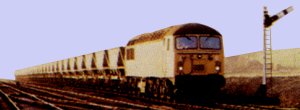
In 1993 the Railways Act was passed, based on the
above mentioned white paper, which separated the infrastructure from the
operational side of the railways. This change ended the regional structure of
British Rail. The track and signalling went to a new organisation called
Railtrack, initially government owned but later run as a fully commercial
company. Railtrack was responsible for maintaining the infrastructure
comprising some 23,000 miles (36,800 km) of track, about half of which is
reserved for freight use. There were 2,482 passenger stations, 1,160 signal
boxes and control centres, 984 tunnels, and some 90,000 bridges. Railtrack
charged private train operators for track access, train time-tabling, and
signalling operations and leased station buildings to operators and
franchisees. The various governments since the 1960's had failed to invest in
railway infrastructure and Railtrack had to both repair the system and make a
profit. It did manage to do this but only by raising the fees it charges the
various train operating companies and by receiving greatly increased government
subsidies.
The goods trainload operation saw sectorisation disappear
and the business was divided up into three separate and 'competing' regional
companies, called Mainline, Loadhaul and Transrail. These companies were
basically 'regional', serving the South East, North East and West of the
country but why the rail system, with only 6% of the countries freight traffic
should be required to compete with itself remains a mystery.
The
parcels and mails side of the business became a fourth company called Rail
Express Systems, commonly abbreviated to 'Res'. This proved to be something of
a sea change for the parcels business and a major revamp of all services was
initiated. The last of the old diesel parcels cars were withdrawn, they had
suffered from reliability problems and many were redundant DMU's with
conventional doors. Roller doors had been fitted to some and were found
preferable on parcels stock but the units were all approaching the end of their
useful life. It is worth noting that the British Railways purpose-built parcels
rail-cars were single units, longer than the passenger equivalents. New
contracts with Royal Mail were signed and new electric multiple unit trains
were ordered to carry the mails.
The charter and Royal Train services
were passed to Rail Express Systems in 1994 as the Intercity system was to be
broken up and could no longer provide a nation wide service, in 1995 RES also
got the contract for positioning empty coaching stock for the three rolling
stock leasing companies (called Roscos).
Freightliners was sold to the
existing management team, albeit with some politically imposed constraints on
the resources it could operate and the services it could offer. Railfreight
Distribution, commonly called RfD by enthusiasts, remained as a British Rail
company and continued to deal with international traffic and the remaining
trivial amount of wagon load traffic.
The passenger rolling stock and
locomotives were sold as a franchise to several Roscos however in practice this
did not work as planned. Following a series of mergers the passenger train
operators now own much of their own stock. The passenger train services were
offered as franchises and thrown open to tender, the franchisees having to hire
their rolling stock from the rolling stock operators.
On the goods side
Transrail was the first of the 'train-load' companies to reintroduce single
wagon load siding-to-siding services in September 1994 under the Enterprise
name. All Enterprise services were diagrammed to run at 60 mph and by 1996
Enterprise was moving over half a million tons of freight a year. By this time
the once profitable fertiliser traffic and chemicals such as ammonia and
chlorine were no longer carried by rail and chemicals generally amount to no
more than half a million tons a year. Grain and other agricultural produce was
also lost with the end of Speedlink but Enterprise has managed to drum up some
business in salt, sulphuric acid and caustic soda. Some wood and small amounts
of paper were still being shipped by rail but coal tonnage had fallen and the
end of the building boom had reduced road stone movements. Oil has seen a move
toward ever larger trains, 2,000 tons became fairly standard in the early
1990's and 3,000 ton trains have been run.
Each of the new companies,
Transrail, Mainline, Loadhaul and RES had their own liveries for both
locomotives and rolling stock but all proved short lived.
In 1994 the
government unveiled a plan to privatise Railtrack by 1996 and the Channel
Tunnel opened. The first train loads of lorries passed through the tunnel in
May and conventional rail freight services began in June. This service allows
direct access for standard rolling stock to and from the UK and the Continent,
although the restricted British loading gauge limits the range of Continental
wagons that can travel to the UK. A train ferry service remained operational
until 1995, mainly dealing with chemicals (which are prohibited from running
via the tunnel) and former continental 'ferry' wagons continue in use via the
tunnel.
On 2 June 1995 a new speed record for British passenger trains
was established when an InterCity 125 reached 154 miles per hour (248 kph). The
train was running on the East Coast Main Line between Newcastle and
Peterborough (on this same stretch of line the steam locomotive Mallard set the
world speed record for steam trains of 126 mph (203 kph) in 1938 as it ran down
Stoke Bank). The new speed record is impressive as it was achieved on
conventional track, the French TGV has run at speeds of up to 320 mph (515 kph)
but that was on specially laid track.
A company called North and South
Railways was formed by the British firms Berkshire Partners and Fay Richwhite
& Co with an American railway company (Wisconsin Central UK) as majority
shareholder. North & South purchased Rail Express Services (RES) in late
1995 but refused to buy any one of the individual trainload freight companies,
insisting that a single national system was the only viable option. In 1996 the
government allowed them to buy all three companies marking the end of the
purely 'British' freight railway.
The new freight company was renamed
'English Welsh & Scottish Railway Ltd.', usually abbreviated to EWS. EWS
got a range of locomotive types including not a few mixed traffic types such as
the class 47's and something like 20,000 assorted wagons with the bulk traffic
business, some of which have not moved for years.
Class 47 in EWS livery
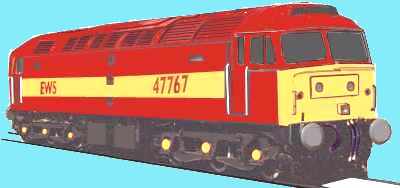
On the wagon front they planned
to scrap all remaining vacuum braked stock (primarily departmental vehicles)
and consolidate what remains. EWS ordered 250 locomotives from General
Motors in the USA, the Class 66, in addition they plan to retain
about 100 class 37's, 100 class 60's and about 50 each of classes 56 and 58.
They will also retain a fleet of class 08 shunters but this will mean the end
of classes 20, 31, 33 and 47 on trainload freight, although they retained a
few of the class 73 electro-diesels for use in the South.
Something
like fifty percent of EWS income goes direct to Railtrack and new rolling stock
and even small quantities of railway ballast are now often shipped by road as
this is cheaper than paying Railtrack's fees. Against this local authorities
are commissioning studies for rail movement of freight to try and reduce the
burden of road maintenance costs.
Railfreight Distribution continued to
operate independently pending sale into private ownership. RfD handled the
international traffic from the channel tunnel and competed with the Enterprise
wagon load service for some business. Their locomotive stud comprised a mix of
class 47 diesels and class 90 electric's.
Also in 1996 the first
scheduled road-rail trailer services were run, some thirty two years after the
British designed equipment was scrapped. The new services use American designed
units developed in the 1980's and they are hauled by regular Enterprise
services between Aberdeen and Northampton. Initially their main cargo was in
paper products but other business is being actively pursued.
Both EWS
and Freightliners (supported by the bus giant 'Stagecoach') put in bids for RfD
mainly because of the potential for Europe wide expansion based on channel
tunnel traffic. In the event the EWS bid was successful and aggressive
marketing and competitive pricing has seen the EWS wagon load business grow to
over one and a half million tons a year by 1997.
Also in 1997 the last
railway franchise was awarded, bringing a final end to British Railways.
New wagon types entered service in the mid 1990's and a memorandum of
understanding has been signed by all the states of the European Community to
establish Europe-wide standards of interoperability for railway stock. In
America, which has one of the most generous clearances on its tracks the
'piggy-back' train has been a regular feature of life since the 1980's. A
typical American piggyback train consists of a rake of low flat wagons onto
which road trailers are lifted for long hauls. On arrival at the reception
terminal the trailers are lifted off and a local contractor provides the
tractor unit to take them to their final destination. On the continent there
are already 'rolling highway' services carrying articulated lorries and their
tractor units between countries, the drivers are carried in passenger coaches
at the rear of the train. In Britain these operations are much more problematic
due to the limited clearances under bridges and through tunnels, the standard
height of the road trailers is thirteen feet six inches or 4.1m which means
that in Britain considerable investment will be required to increase the
clearances above the existing track. This in turn means that entirely new
designs of wagon are required and the first on the British market was the
Eurospine wagon developed by Thrall (UK) Designed to carry forty foot
containers and conventional road trailers up to 3.6m high on British lines this
wagon does not carry the road tractor, only the trailer, and at present it can
only carry reduced height trailers in the UK due to the tight clearances (see
Fig___). Eurospine entered service in 1998, the first application being a daily
service transporting purpose-built (lower than normal) road trailers for Parcel
Force (the Post Office Parcels service) between London and Millerhill (near
Edinburgh in Scotland). Two Eurospine sets are coupled to the rear of one of
EWSs regular freight hauls for this service and EWS has purchased another
twenty sets from Thrall. Freightliner is a supporter of the Piggyback idea and
in 1998 they began operating a daily service carrying specially built road
semi-trailers of chemicals between Manchester Trafford Park and Tilbury on
low-loading wagons hired from G. E. Rail Services.
Freightliner has
also invested in some French built 'Multifret' wagons which can carry
containers or road-rail 'swap-bodies', the swap body is basically a road rail
container configured like the trailer of a conventional articulated lorry but
without the wheels. Babcocks have now entered the field with a wagon called the
Mega 3 Pocket wagon, able to carry two twenty foot containers, a single
semi-trailer or a swap-body. Pocket wagons are basically a drop centred wagon
but with the sides of the central well built up to form a 'pocket' (see
Fig___). Babcocks unveiled the prototype at Rosyth in 1998 and claim it can
carry larger loads than the alternative designs currently in service.
The European Community, concerned about the cost of road maintenance,
congestion and pollution, is pressing for a European network of railway
services for the piggy back type stock with transit speeds of 60 mph. There are
at the time of writing doubts about the British part of the network as this
will require about six inches of increased clearances on the affected lines.
The development of both the piggyback service and the swap-body services
(already common on the continent) depends entirely on obtaining the money to
make the necessary modifications to the track clearances.
The freight
operators (EWS and Freightliners) are keen to see a basic 'piggyback' network
established in Britain and are pressing for improvements to the clearances
available on main routes. Railtrack initially expressed support for this idea
and joined with several other parties to form the 'Piggyback Consortium' to try
and raise the money for the project. The eight foot two inch wide 'swap body',
built to suit the standard pallet load and increasingly popular on the
continent, is one area where easing of clearances would be a major advantage to
the freight business.
If the original plan goes ahead there will be two
lines running from the channel tunnel to London and thence up the east and west
coast main lines able to carry piggyback road trailers in so called
'pocket wagons', swap-body loads and the increasingly common nine
foot six inch high ISO containers. Even if the money were forthcoming this work
will take several years to complete and the British network is unlikely to meet
European standards until well into the twenty first century.
Across
Europe there was a growing realisation that moving semi-trailers by rail could
effect great savings on road maintenance and a consortium of interested parties
was set up, calling itself SAIL - Semitrailers in Advanced Intermodal
Logistics. The purpose was to work out the detail for a European standard for
this kind of traffic, building on the work done with 'pocket wagons'
but without requiring a crane to lift the trailers into position. The British
did not take part in this consortium and given the restrictions of the British
loading gauge they may well not be able to make use of the technologies
developed for it.
There was some doubt about Railtrack raising
sufficient funds for the planned piggyback routes in the UK in the late
1990's, and as far as I am aware there is no definite plan to carry
through this work under the changed conditions of 2003. Ultimately the
Railtrack management proved unequal to the task and the quality of work
undertaken by Railtrack and by the companies it employed was not up to the
required standard. By 2001 Railtrack was in financial trouble and by the end of
the year it was in receivership. There had been a number of serious failures
including trains being derailed due to the failure of track maintenance
overseen by Railtrack. In June 2002 a new organisation, called Network Rail,
bought all the rail related business from Railtrack for some 500 million
pounds.
Network Rail is a government backed not-for-profit company
controlled by train operators, rail unions and passenger groups. It has
promised it will be "dedicated to the interests of rail users". Unlike
Railtrack, any profits will be ploughed back into the business rather than
being split between shareholders as dividends and management incentives will be
tied to performance targets such as safety and punctuality rather than profits.
The Strategic Rail Authority will provide a further £4bn as a backstop
contingency fund to Network Rail. Network Rail is treated as a subsidiary of
the Strategic Rail Authority for accounting purposes and this caused something
of a row in 2003 when the SRA appeared to have made a massive loss. This was in
fact not the case, the appearance of a loss was due to the way the government
required the accounts to be drawn up. By late 2003 Network Rail had decided to
stop using outside contractors (this 'outsourcing' as it was called was popular
in many industries in the later 1980's and through the 1990's. It was widely
favoured by accountants but its practical value was being questioned by the
turn of the century).
Network rail currently (2003) believes it can
trim the costs of the required work to less than a third of the figure
Railtrack had arrived at, however there is still doubt as to how much work will
actually be done and passenger travel appears to have been given priority over
freight improvements.
Current Organisation of the Railways
I am not sure I
fully understand the system that has replaced British Railways, my own interest
in the railways peters out around the end of the green diesel era. I gather the
structure was devised to allow the government to do a bit of carpet bagging
rather than to set up an efficient railway system, however I believe the
structure is as outlined below.
Following privatisation, British Rail
was divided into two main elements. In outline, the first consists of the
national rail network (track, signalling, bridges, tunnels, stations and
depots) with the second element being the operating companies whose trains run
on that network.
In supporting roles there are a number of new
organisations and the existing Health and Safety Executive. Of the new bodies
perhaps the most important is the Strategic Rail Authority (SRA) which formally
came into being on 1 February 2001 following the passage of the Transport Act
2000. Its task is to provide a clear strategic direction for rail transport in
Britain, to promote rail passenger and freight transport and to encourage
private investment in the rail industry. The first formal submission was
produced in January 2002 laying out a suggested plan for ten years.
The
Rail Regulator is another new organisation, consisting of a single appointed
individual with a small supporting staff (although, at least theoretically,
independent of Government). The job of the Rail Regulator is to provide
economic regulation, controlling the charges made by the organisation operating
the infrastructure (currently Network Rail, formerly Railtrack) for use of the
system by the companies operating the trains. International passenger and
freight trains are licensed by the International Rail Regulator (IRR), in
practice this is the Rail Regulator but there is a legal distinction between
the two roles.
Another new body, set up in 2003, was the Rail Safety and
Standards Board. This replaced the Railway Safety organisation, implementing
one of the core sets of recommendations from the second part of Lord Cullen's
public inquiry into the Ladbroke Grove train accident. The RSASB is a
not-for-profit company owned by the railway industry. It is independent of any
single railway company and of their commercial interests. Rail Safety and
Standards Board's 15-strong Board comprises an independent non-executive
chairman, three executive directors, six industry nominated non-executive
directors, four independent non-executive directors and one non-executive
director nominated from the Strategic Rail Authority.
The Health &
Safety Executive (HSE) is the regulatory authority for health and safety on the
railways.
The company operating the railway infrastructure was Railtrack
Plc but, in October 2001, the company was placed into railway administration by
the Secretary of State for Transport, Local Government and the Regions. The
replacement is Network Rail, which maintains the track, signals and major
stations. The smaller stations are run by the companies operating the passenger
train services.
The train operating companies (TOCs) are licensed by the
Rail Regulator but the franchises they bid for are awarded by the Strategic
Rail Authority. A TOC can run passenger trains (and the associated stations),
freight trains or both.
There are currently (2003) four companies operating
railway freight -Freightliner, EWS, Direct Rail Services and GB Railfreight
(part of GB Railways Group PLC). The last is the only one operating both
passenger and freight services. In early 2001 the SRA published its strategy
for railway freight and details of how this is intended to dovetail with the
grants available from government to promote railway freight.
There are
a variable number of passenger train operating companies which bid for
franchises to operate services. Many of the current passenger rail franchises
are due to expire by 2004. In late 2002 the SRA issued a new policy document,
outlining its latest thoughts on awarding franchises, hopefully avoiding the
errors made in the first round. This may not be the final system to be
implemented as this is now a commercial operation rather than a public service.
As an example of what this means passenger train companies instructed their
drivers not to stop at stations near the end of the routes if this meant they
would arrive late. Apparently the revenue from short haul tickets was
outweighed by the fines for being late.
The original plan was to have
another raft of companies who owned the engines and rolling stock, leasing
these to the train operating companies, however this part of the plan has not
really worked out as intended. These companies are usually referred to as
ROSCOs which I believe stands for Rolling Stock Companies. The idea seems to
have been to maximise the money passed to the government, who tax each
transaction. In the event the banks saw an opening and purchased the ROSCO's
(the three main ROSCOs are bank owned). They also managed to have the rules
changed so they could charge whatever they like for hiring out the stock, the
net result being they receive about a 30 percent return on their investment and
siphon off something like 60 percent of the profit from the train operators.
The government still (2003) believes this is a 'good' way of working and is
reluctant to sacrifice its cut of the money flowing through the system by
allowing train operators to own their own trains. The freight operators, EWS,
DRS and GB Railfreight have all purchased their own locomotives however and I
understand that other companies are considering similar moves. Largely as a
result of this, but with some additional money being spent bringing the track
and stations up to standard, the railways currently (2003) require roughly
three times as much tax payers money as they did under British Rail but the bulk of this is siphoned off by the bank-owned ROSCOs. The
official position is that this subsidising of the banks is a 'good thing' for the railways, although the logic behind this
seems (to me at least) somewhat obscure.
In 2006 it was proposed in Westminster that a good way of reducing the rail subsidy (by this time four times as much as was spent on BR) would be to reduce the number of services, leaving the banks to retain the bulk of the public money paid in.
^
Go to top of page
International Good Guys ~ Laughing in the
face of advertisments since 1971 ~ Site maintained by

All material Copyright © Mike
Smith 2003 unless otherwise credited










































